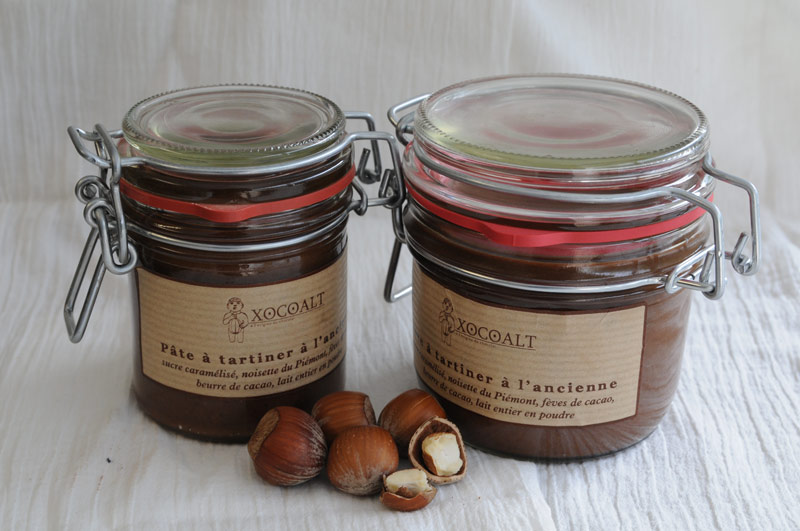Tablettes by Jean-Louis Nomicos: seducing Parisian gourmets with Mediterranean charms
Tablettes is a modern gastronomic take on Mediterranean cuisine of a former Ducasse protege Jean-Louis Nomicos. The chef was awarded two stars when working at the restaurant Lasserre and now at his first own establishment he treats diners to a superb one Michelin star dining.
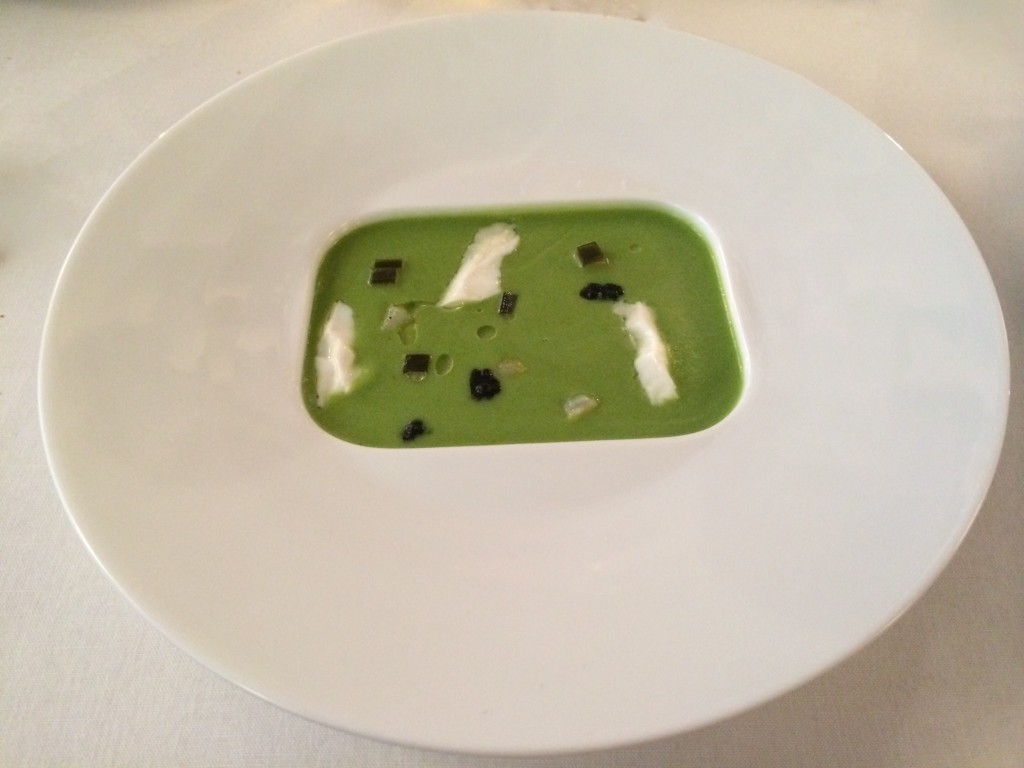
Nomicos’ cooking ethos goes along these lines:
“Flavours do not mix, they cohabit harmoniously, and what appears arid, dry and concentrated reveals generosity and kindness to curious spirits and palates.“
And in his often changing menu he meticulously sticks to this approach creating sublime, balanced and interesting plates.
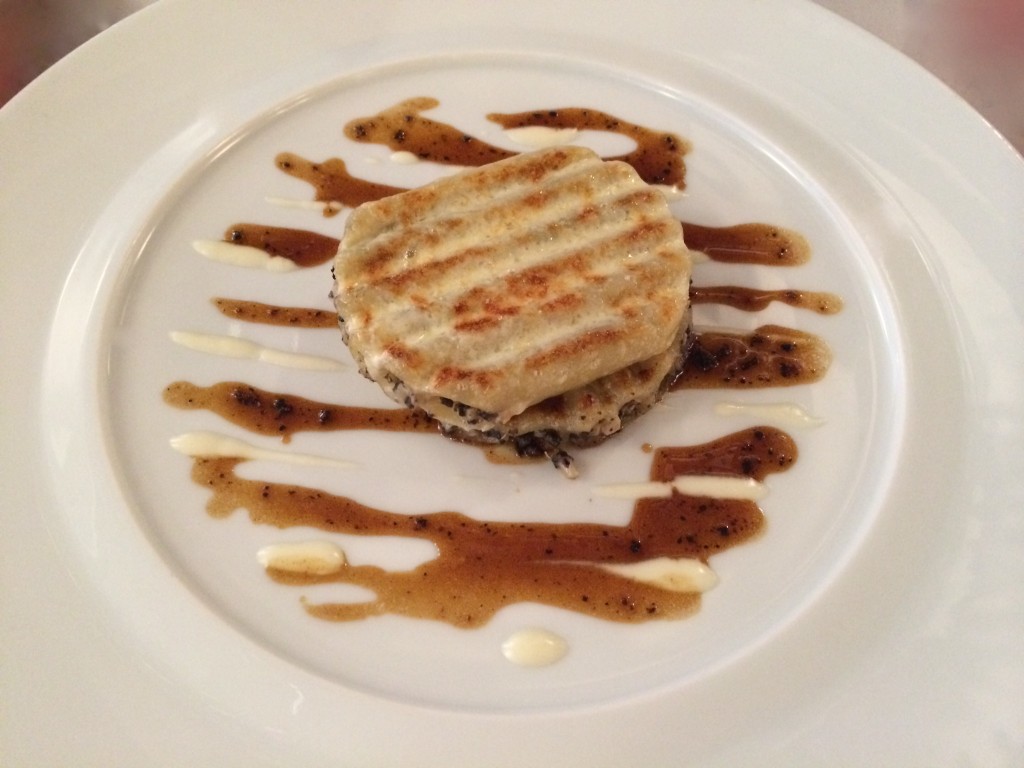
Flexibility is reflected in the choice from a la carte, more affordable lunch (€42), four-course discovery (€80), six-course seasonal (€120), and eight-course degustation (€145) menus. The last two include the chef’s signature macaroni dish. The menus are great value for money since both of the later include the lobster, macaroni and beef dish together approaching €200 when ordered a la carte.
The already legendary Macaroni with black truffles, foie gras, celery served in a veal juice, are crisp on the top and taste sinfully yummy. As the chef fell in love with his Italian wife, at the same time he enamoured the fragrant truffles of her home country, using them regularly in many dishes.
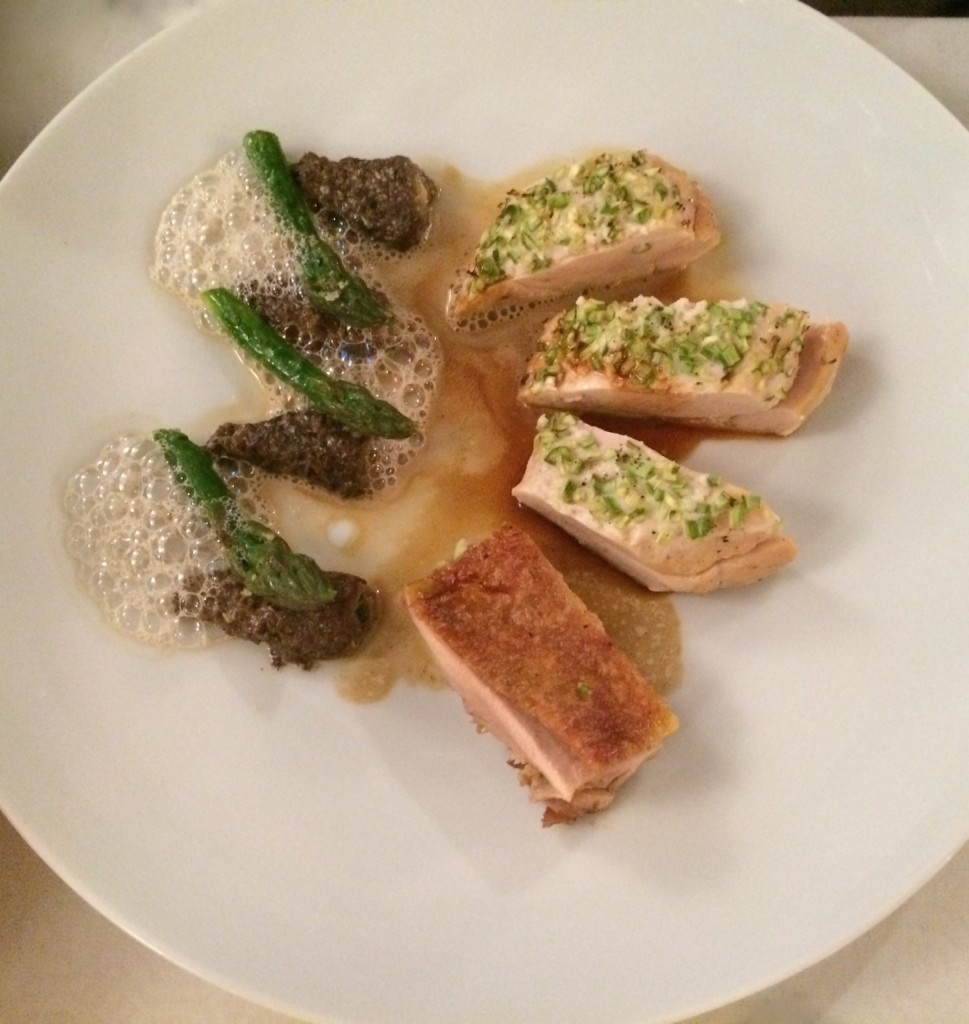
To get a more precise sense of the chef’s seasonal orientation in the choice of his ingredients I tried the summer evoking Zucchini Velouté with fine parmesan shortbread (Velouté de courgette). It was citrusy fresh, with flashes of richness from creamy cheese, like a hot summer day – heavy in its heat, while refreshing with the sun’s light.
As a daily special was included the Stuffed Bresse chicken in jus from Arbois wine with stuffed morilles and asparagus tips. It was served in two variations, as skinless breasts sprinkled with spring onions and with a crispy skin for all these, who relish this more naughty part of the bird. Nomicos cooked the by AOC status stamped chicken to such tenderness that its texture was very close to the cooked morilles mushrooms.
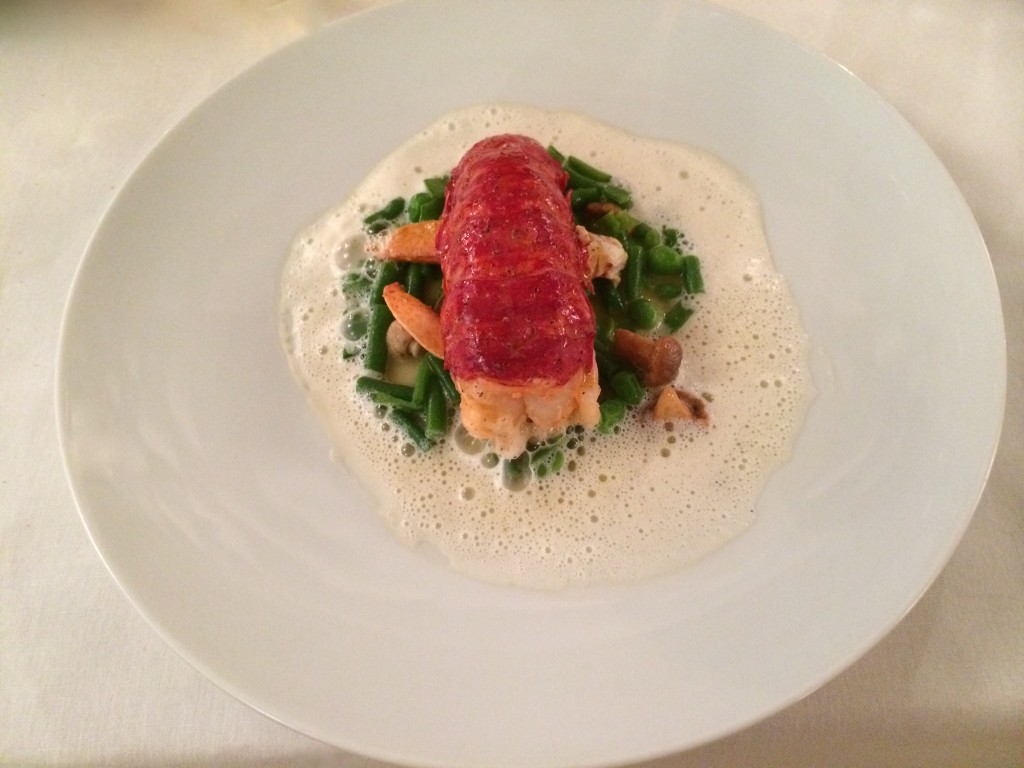
I had to try the Roasted lobster with mushrooms, French beans and peas in delicate milky verbena emulsion. The massive meat of the lobster was so delicate and the verbena emulsion so Provencal that for a minute I thought that I am sitting at a table in by-sun-warmed, high-perched southern village.
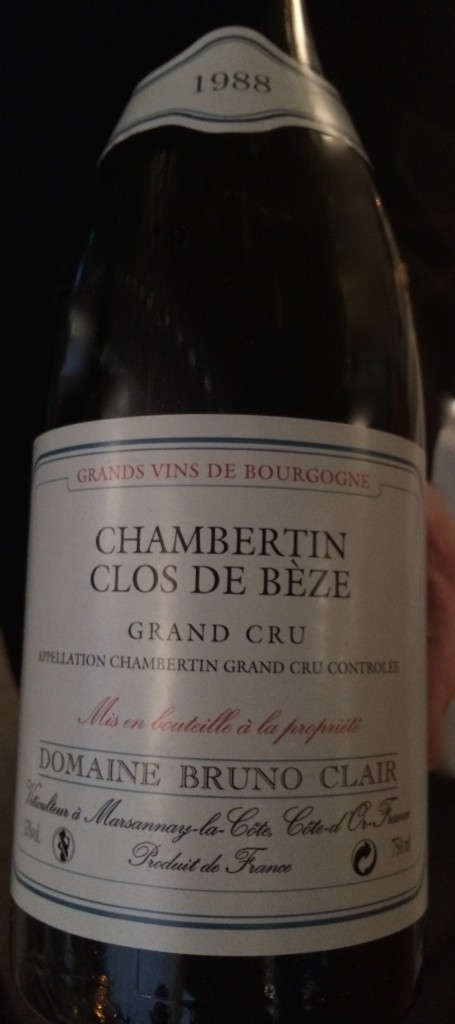
The chef’s elegant food calls for an elegant wine such as well-aged Burgundy. We went for a 1988 Grand Cru Chambertin, Clos de Beze. This red lean beauty queen is produced by Domaine Bruno Clair. Lavender on the nose once again evokes the South. This bottle was one of Bruno’s first vintages at the family domaine that he inherited. Mostly centenary vines prevailingly planted in 1912 yield complex wines with vigour of the fruit, but also enough balancing minerality.
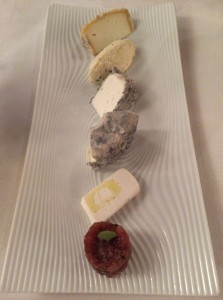
Selection of goats cheeses from Dominique Fabre concluded our romantic gustatory trip back home in the Mediterranean in the fresh spirit. It was interesting to try a wide variety of cheeses from one producer.
Being located in the Paris’ most noble neighbourhood of the 16th arrondissement, the interior of the restaurant is sleek and refined. Colourful design reflecting the chef’s Mediterranean background in tones of orange, sand, and pebbles transfer the present diners to Southern France and its playful nature. The walls were formed with interlaced strips of sand-grey wood, resembling a deconstructed basket, the typical market accessory in France.
Address: 16 Avenue Bugeaud, 75116 Paris, France
Contact: +33 1 56 28 16 16
Open daily for lunch and dinner.
CLOSED Lengue: avant-garde last bottle concept at Japanese izakaya in Paris
As Lengue closed its doors, the owner has opened a new izakaya called Sagan in the Odeon district. A Parisian friend went and not just from his photos but also his fresh report in May 2022, the food looks as delectable as before, while the portions increased beyond a typical izakaya and French cuisine entered the menu’s repertoire as the Michelin Guide points out.
Sushi and black cod miso flocked in thousands of variations to Paris and penetrated well beyond the Asian restaurants into the trendy French brasseries and restaurants, yet Lengue reminds some of us uninformed westerners that there is more to Japanese cuisine than a chunk of raw fish and sticky rice. To fill the gap in the Parisian Japanese repertoire, the chef-proprietor Katsutoshi Kondo, ex- l’Atelier de Joël Robuchon and Aïda, opened Lengue izakaya in the intellectual and artsy Latin quarter.
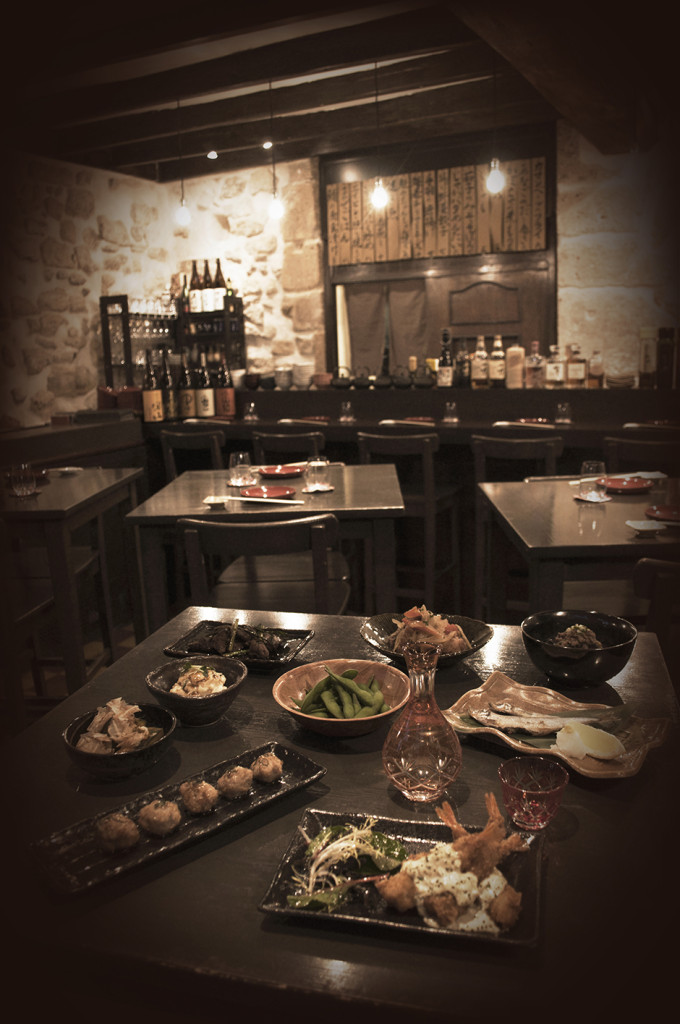
The Japanese pub concept at Lengue
The difference is that the spanish fried croquettes will have a Japanese twist, there will be tonkatsu, vinegary sunomono pickles, sashimi, yakitori, beef tatami, etc. on the menu.
As much as in Spain, this concept lends itself to wine and other beverages as the score keepers. It is not about pairing the wines with food. The philosophy is to have great wines and some tasty food to enjoy it all together. Wine (or other beverages) must make the impression though.
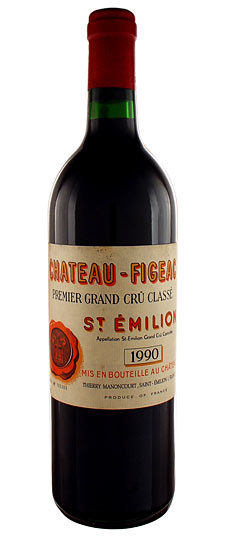
That is probably where the “Dernière Bouteille” idea was born at Lengue. On a special wine list every single last bottle in the cellar is being featured. It is a hit or miss, but not on a big scale, since the prices are some of the most customer friendly in all of Paris. You can get a smile evoking bargain of a great vintage from a reputable producer – like we did with our bottle of St Emillion Chateau Figeac 1990; or you can get a corked or vinegary 1970s or older wines.
To be fair to Lengue, the risk is highlighted by the polite japanese wine waiter, and he is also eager to advise well depending on your budget and taste preferences.
He nodded to my choice of 1990, which was a superb year in St Emillion not only for the utterly expensive Cheval Blanc. Its neighbour Chateau Figeac rewarded us with supple tannins, still communicating juicy red fruits through its 24 years of life. This perfectly developed Bordeaux with its muscles stretching rather elegantly played the same notes with fatty beef tataki in soya sauce, onions and shiso leafs. The Figeac was like a best friend supporting the meat rather than overshadowing it.
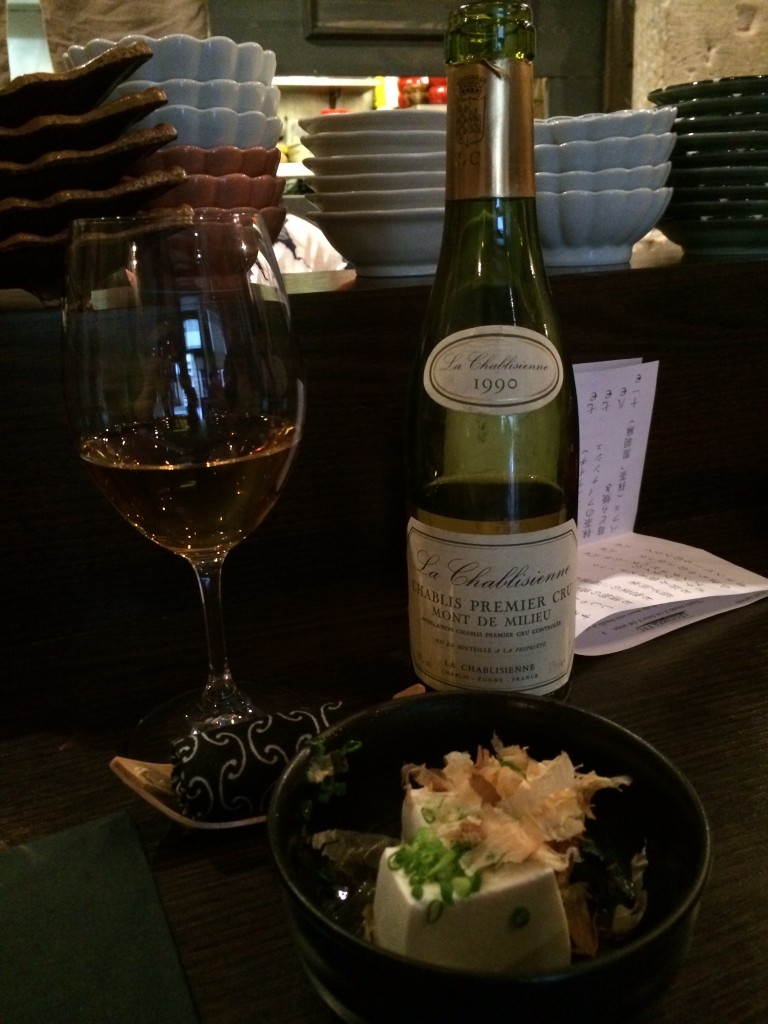
The 1990 became the vintage of the evening as we started with a half bottle of white Premier Cru Chablis from La Chablisienne. Chosen from the regular wine list, the wine was very showy and slightly oxidised giving off an enjoyable nutty character, roundness with an off-dry mouthfeel. Not an ideal aperitif, but the fried camembert worked magic with this expressive wine. The lightly seasoned soft tofu also got a kick from it.
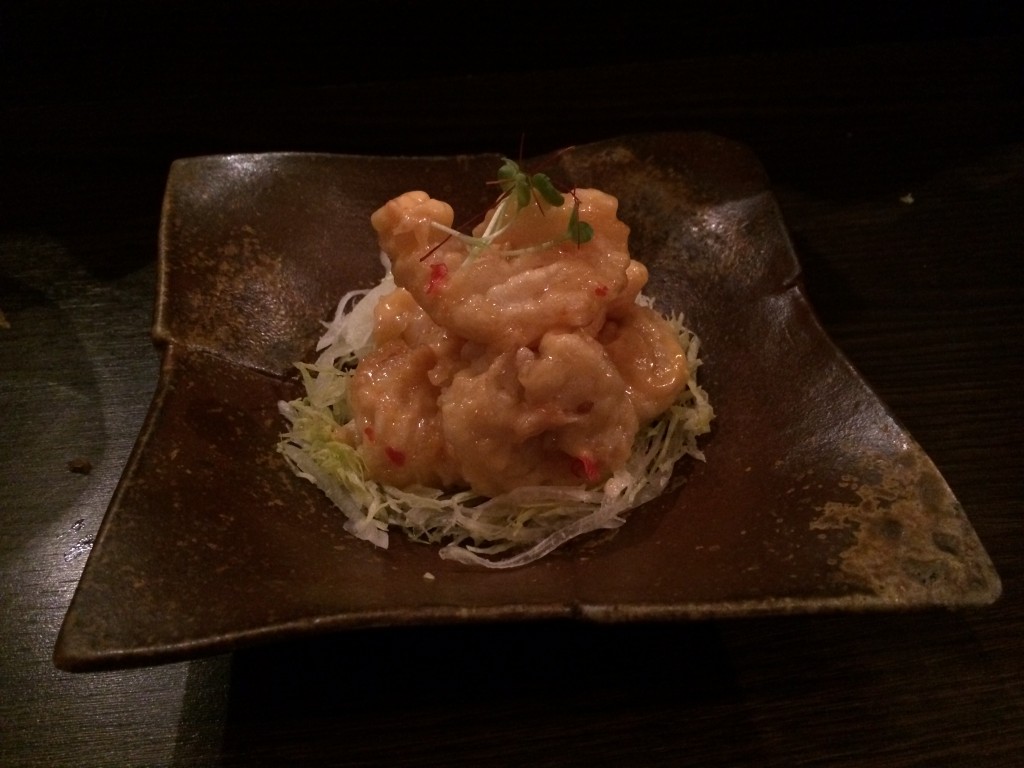
The shrimp tempura made in the creamy mayonnaise sauce à la Nobu could not befriend the sweetness of this wine. Its oily nature needed a zap of acidity found more in younger wines. But this was me, the wine geek, I had to ponder over the pairings.
Since we drunk the “Dernière Bouteille” of the 1990 Figeac (sorry you missed it!), there were still many treasures to be found.
Like the DRC from one of the top millennial vintages – 1982. The Burgundy wines are even more sensitive to proper storage and provenance can become an issue when it changed owners’ hands too many times, so this choice might be pricy without a reward.
My favourite red Hermitage from Paul Jaboulet was featured in 1987 vintage for €107. I would take the risk (Yet, I am a wine buff and food addict, so it still might be too much for others who would rather spent it for a pair of shoes).
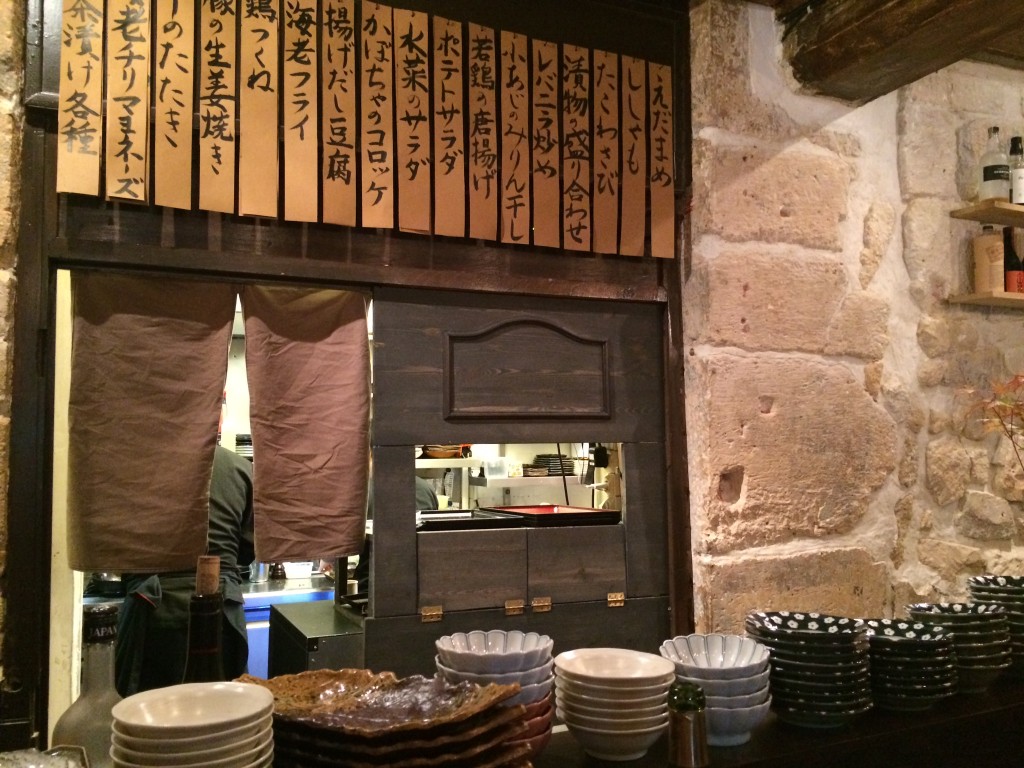
Lengue cannot be a true Japanese establishment if there were not sake, shochu, beer and some Japan-inspired cocktails available, so one is free to choose what beverage appeals to him most.
The interior goes hand in hand with Lengue’s casual purpose. Set in a veritable old Parisian environment with wooden beams sheltering the overhead space and pale sandy coloured stone walls, the wooden bar with kitchen right behind it highlighted that food and drinks have at least an equal status here. The more open upstairs room will be acceptable for claustrophobics, where the tight cellar-like vaulted space downstairs remains for those who like to hide from the curious tourists peaking inside. Next to the stellar wine selections, it is also the authenticity of Lengue, confirmed by tables full of Japanese customers, that is its real draw.
Address: 31 Rue de la Parcheminerie, 75005 Paris, France
Phone: +(33) 1 46 33 75 10
Opening hours: Lunch in form of bento boxes: Tue-Sat 12noon-3pm (last order at 2pm)
Dinner: Tue-Sun 7pm-midnight (last order at 11pm)
Alain Ducasse chocolate manufacture in Paris: the wizard and the businessman goes all cocoa
A sublime fresh cocoa scent lures you in. Mindless about your feet stumbling on the old Parisian cobbled street, as if you were about to fly – like a bee seduced by a fragrant flower, your nose cajoles you further inside the indistinct courtyard. In the midst of the poised hive of activity at the crossroads of the third and eleventh arrondissement nests the Alain Ducasse chocolate manufacture.

Now, it strikes you – right here, behind a prodigious thick glass wall nests a little kingdom of chocolate. This is Ducasse’s boyhood fantasy becoming reality of a grown-up man as the cocoa kingdom is his first chocolate manufacture that he added to his gastronomic-driven empire of restaurants, cookbooks, travel guides and Relais & Châteaux style luxury hotels.
The Alain Ducasse chocolate factory is a beguiling attraction in the quirky 11th district of Paris, cozied in a little street just off Bastille. As you venture inside, marvel at the chocolate specialties displayed like precious jewels in a glass bubble arching over a table serving as the centre piece of the boutique cum manufactory. It would be a sin NOT to pick up one. Unlike for Eve not resisting her lust for the apple the Paradise, chocolate is allowed in today’s world where its antioxidant and other healthful properties are praised by nutritionists.

Back to pleasure, whether it is a mere joy from watching the chocolate production process, or savouring the handcrafted bonbons, bars and other in cocoa dipped morsels any chocolate lover will be moved emotionally and physically. Even the multi-Michelin decorated chef, Ducasse, calls chocolate “a terribly sensual and bewitching substance“, so bite in!
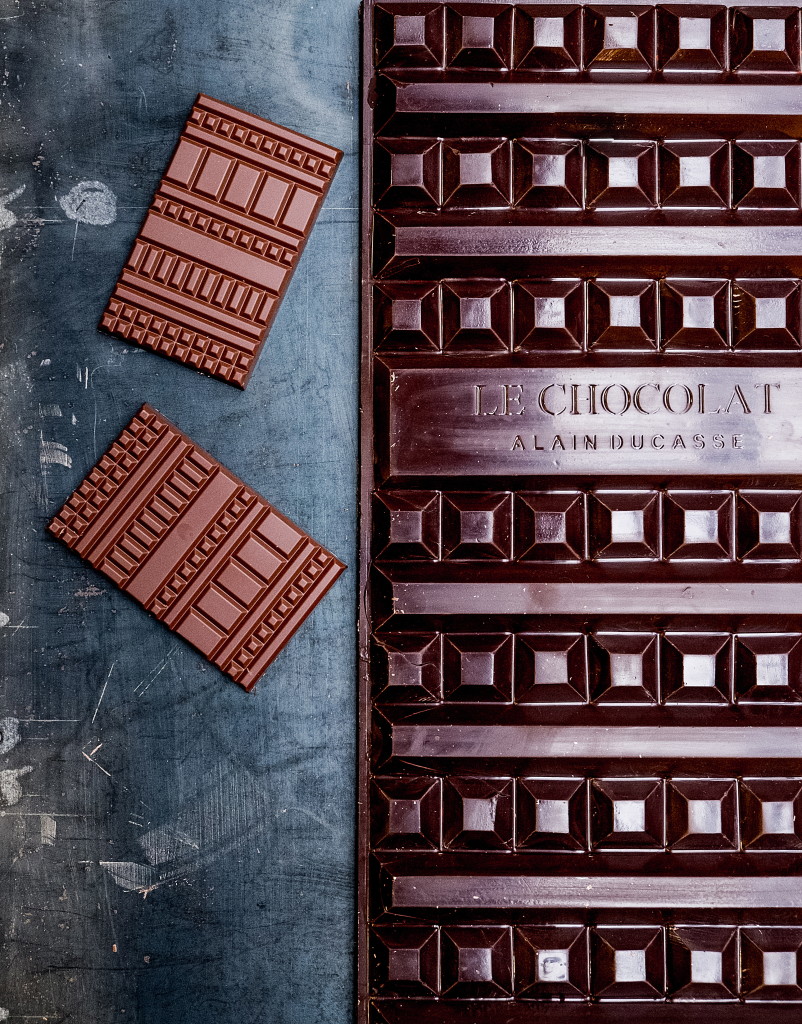
It is a smart business step to dip one’s nose into chocolate these days – with its quality returning back its heydays, also top chefs find chocolate attractive, and why not? The celebrity chef cult is now extended with Alain Ducasse’s new title – an artistic director of chocolate manufacturing. Who would not desire his job – he tastes and suggests variations in the chocolate products made in traditional fashion, and consults his artisan chocolatier Nicolas Berger how to make the already delicious truffles and other luxurious cocoa-dusted delicacies even tastier.
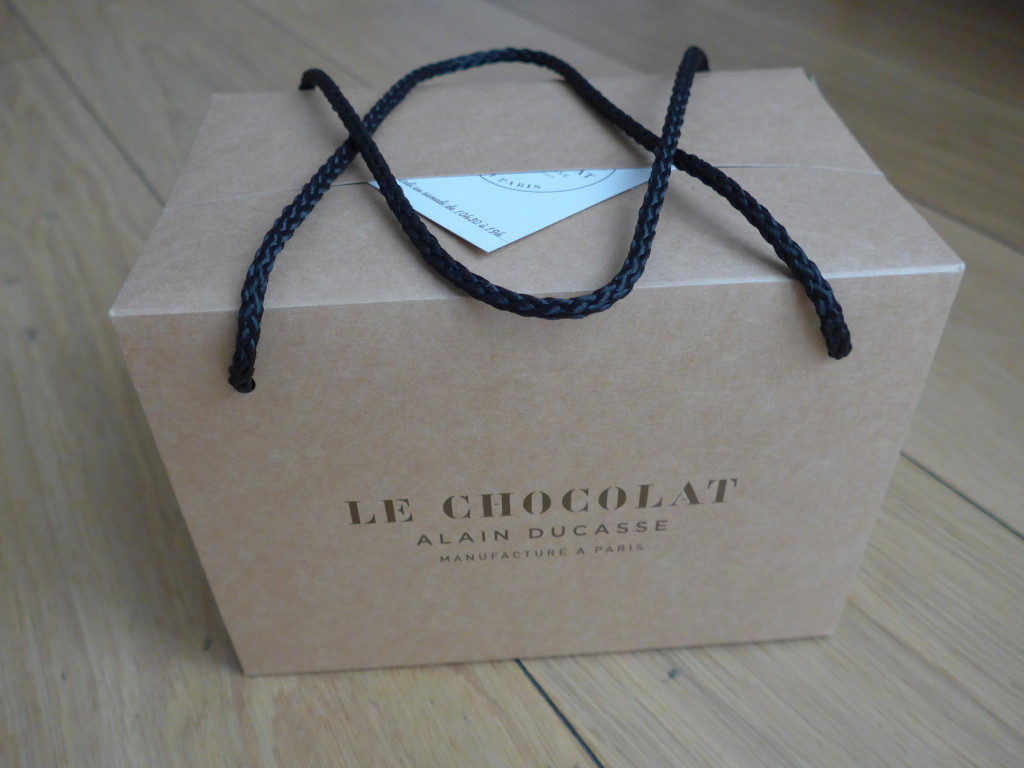
Packed luxuriously in an eco wood paper box, that can be recycled, but looks chic when carried around Paris, I rarely resist buying a couple of the superb quality chocolates. The shape and breaking style of the chocolate bars are masterminded by graphic designer Pierre Tachon. These gourmet specialities do not come cheap, but this makes them more special treats and not a quantum of sugar consumed on one occasion. The standard chocolate bars weigh 75g and cost between €7 and €10 (the more rare the origin of the cocoa the higher the price), but the range balloons to giant one to three kilo suitable for the serious chocoholics. Most contain vanilla pods and fleur de sel uplifting the cocoa fragrances.
Alain Ducasse chocolate manufacture in Paris makes either single origin bars, house blends reflecting the “traditional” style and more seriously sweet chocolate specialities such as the “mendiants” and “filled (fourrée)” bars.
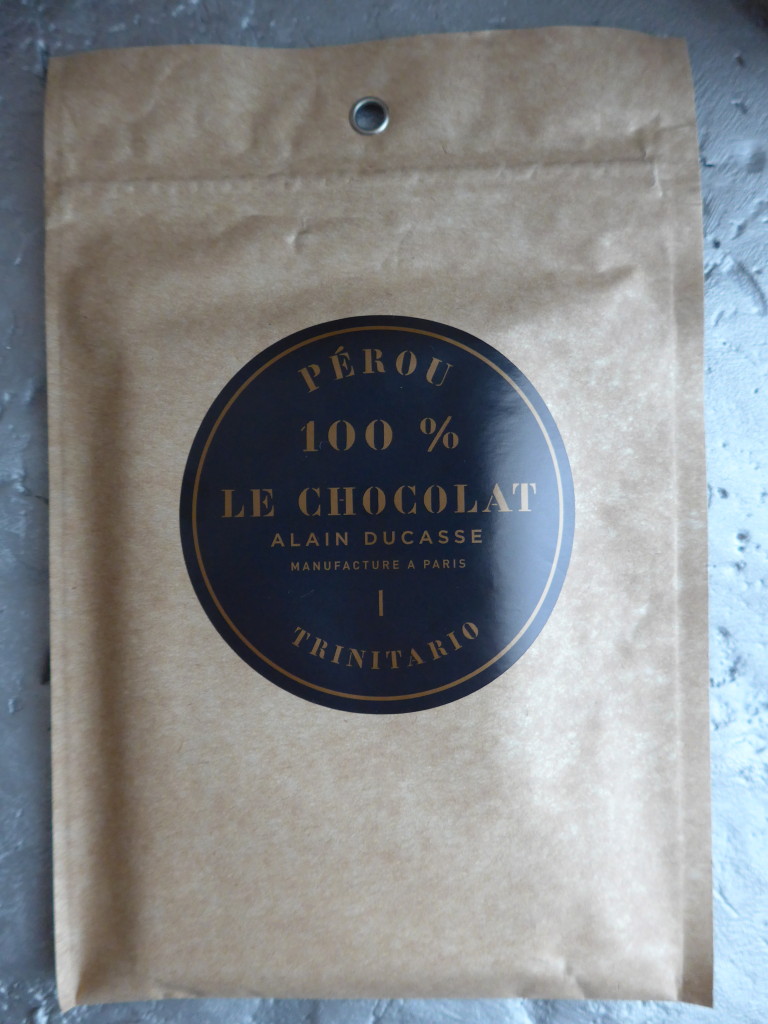
Alain Ducasse chocolate 100% Peru Trinitario is so far the only pure cocoa bar. Its deep earthy taste with notes of bitter citruses and coffee is not for every palate, but the 75% Peru in Trinitario or Criollo cocoa bean varietals are both more tender with still prevailing citrus and coffee notes, hazelnut and vegetal freshness and good equilibrium of tannins and acidity. The Criollo comes from the lighter coloured and most refined Porcelana, considered the holy grail of cocoa, that makes the complex balanced dark chocolate look almost like a milk bar. The Non-conched version is crunchy with the unrefined sugar changing the texture and aroma to fermented grape juice and lily flower scents.
The Venezuela 75% dark chocolate bar is excellent as always when I savour the Chuao plantation its complex sweet honey, intense flower bouquet and dried fruits flavours come to overwhelm my sensuous palate. While the all blend of Venezuela 75% dark chocolate bar with its more dusty coffee and wood bark slightly covers the fruity and floral aromas found otherwise in the Chuao.
Ducasse must think of diabetics in today’s demanding consumer world, and his 85 % dark chocolate blend is sugar-free as the more sweet, yet much less calorific maltiol is used instead. Maltiol tastes much better than the herbaceous stevia, that is also used in the bar. Maltiol’s drawback is that it is not purely natural. Fruity, flowery lively flavours mingle with dry rustic character and rough mouthfeel, but it is a very intriguing ‘almost’ guilt-free treat.
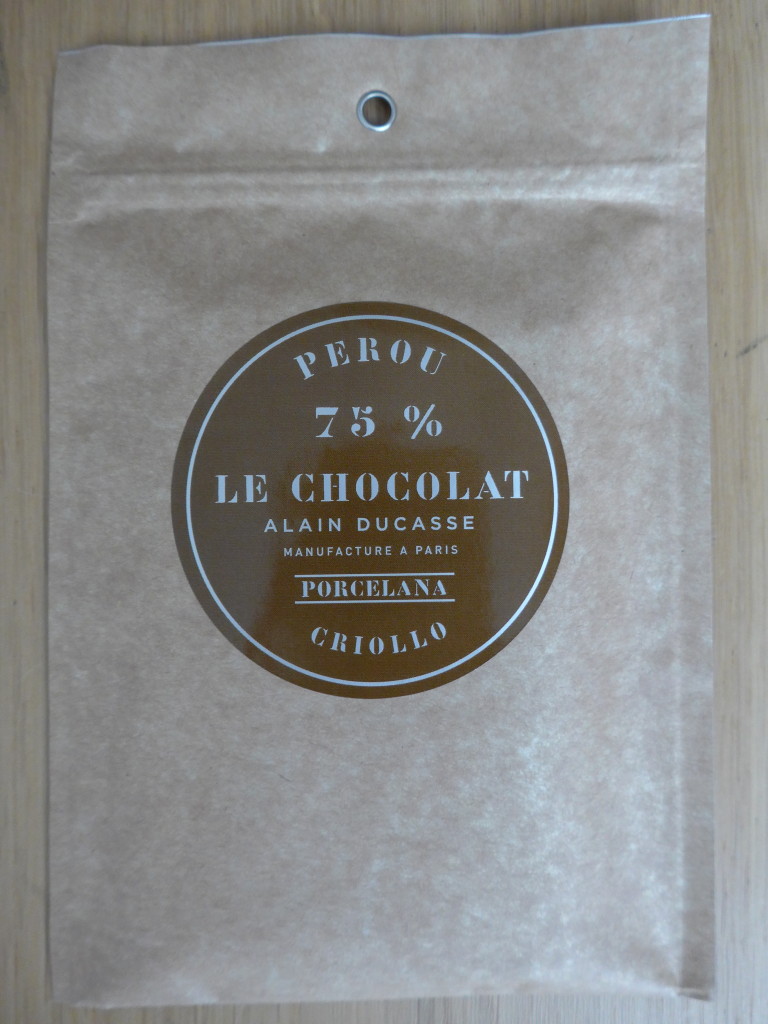
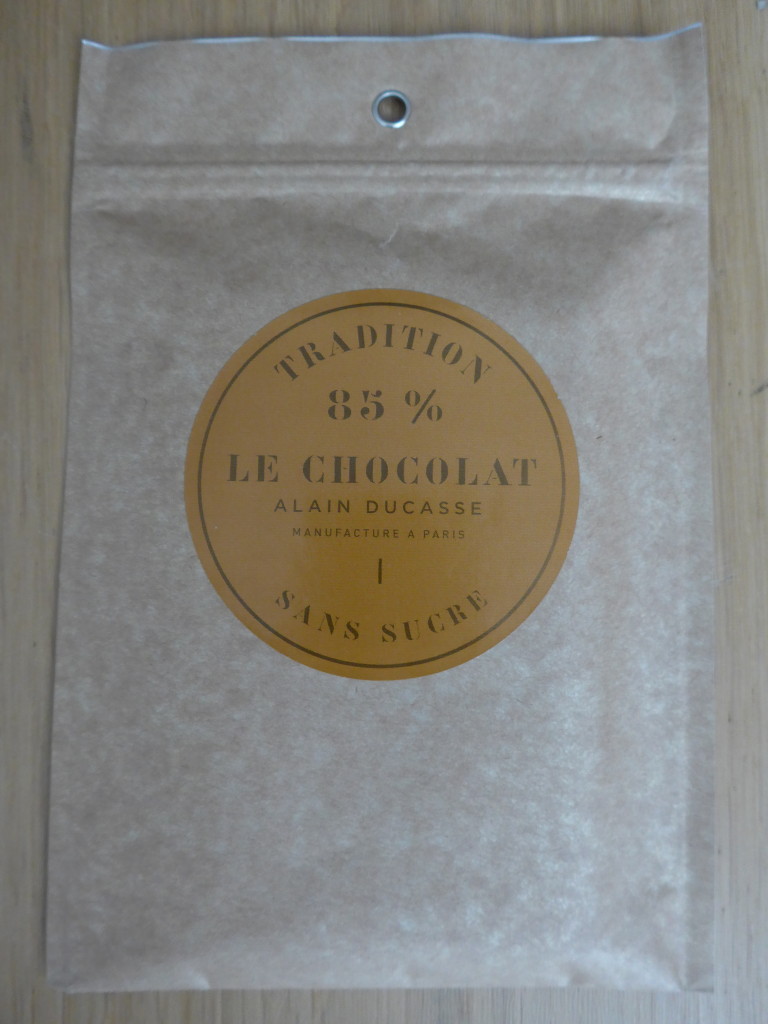
From the other single origin bars I highly recommend the fruit-bursting, spicy and exotic incense evoking Vietnam 75% dark chocolate, and the Dominican Republic 75% Hispaniola, that like a Caribbean dance evokes freshness, fun, curiosity and exotic fruit fragrant oils with floral scents.
The Filled – ‘Fouree’ chocolate bars are enrobed by a thin chocolate layer. The Hazelnut Praline with Fleur de Sel has more crunch thanks to cracking biscuits fused with generously pounded hazelnuts (60% of the total are hazelnuts). Its contrasting texture with melting smooth chocolate touches and calms tense nerves of anyone finding peace while crunching on something (nuts supply the nerve-calming B vitamins).
The Chocolate Mendiants are bathed in 75% dark chocolate from Venezuela and permeated with caramelised sweet nuts and/or dried fruits. The Caramelised hazelnut in the Piedmont fashion has crunch of the whole nuts, while the Mixed Fruits Mendiant is impregnated with almonds, figs, sweetened oranges, grapes and pistachios, is more like an interesting but natural chocolate cake and not just a bar.
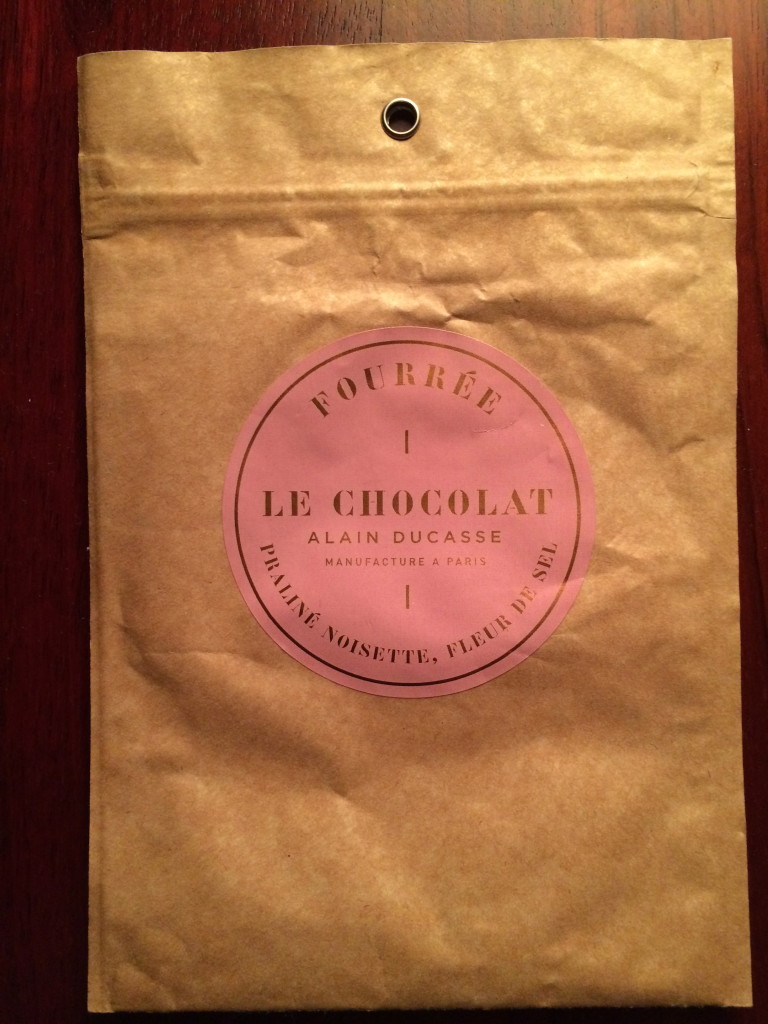
Alain Ducasse chocolate bonbons underline creativity in “double-bites” and “ganaches gourmand“; pure origins in the ganaches from Java, smooth Madagascar, deep Peru, Trinidad and fruity Venezuela; honour tradition with “old fashioned” pralines with crunchy almonds, hazelnuts, roasted coconut, pistachio or peanut; the creamy “rectangular truffles” enrobing either a dark chocolate ganache, vanilla ganache or orange praline; and fanfare for the “rochers” garnished with nut or caramelized fruits. The rochers are the pinnacle of indulgence in the Ducasse’s noble stable of treats. A small selection of them is offered after a meal at Ducasse’s gastronomic restaurants such as the flamboyant Luis XV in Monaco.
Just recently, in March 2014, a new boutique in Saint-Germain-des-Pres (26, Rue Saint Benoit) opened its doors catering to more chocolate lovers venturing rather to this artistic quarter of Paris then to the quirky Bastille area.
40, Rue de la Roquette, 75011 Paris (Metro: Bastille)
Boutique only at 26, Rue Saint Benoit, Paris, France
+33 1 48 05 82 86
Tue-Sat: 10:30am-7pm
Frenchie: bistronomy's little treasure in Paris
Frenchie embodies an old Parisian ambiance blended with modern international gastronomic fare rooted in its French history.
The name of this culinary and vinous enterprise comes from a nickname given to its French chef and founder Gregory Marchand when he worked in the kitchen of Jamie Oliver’s restaurant Fifteen in London. The chef’s past also appears, like in an open book, on your plate.
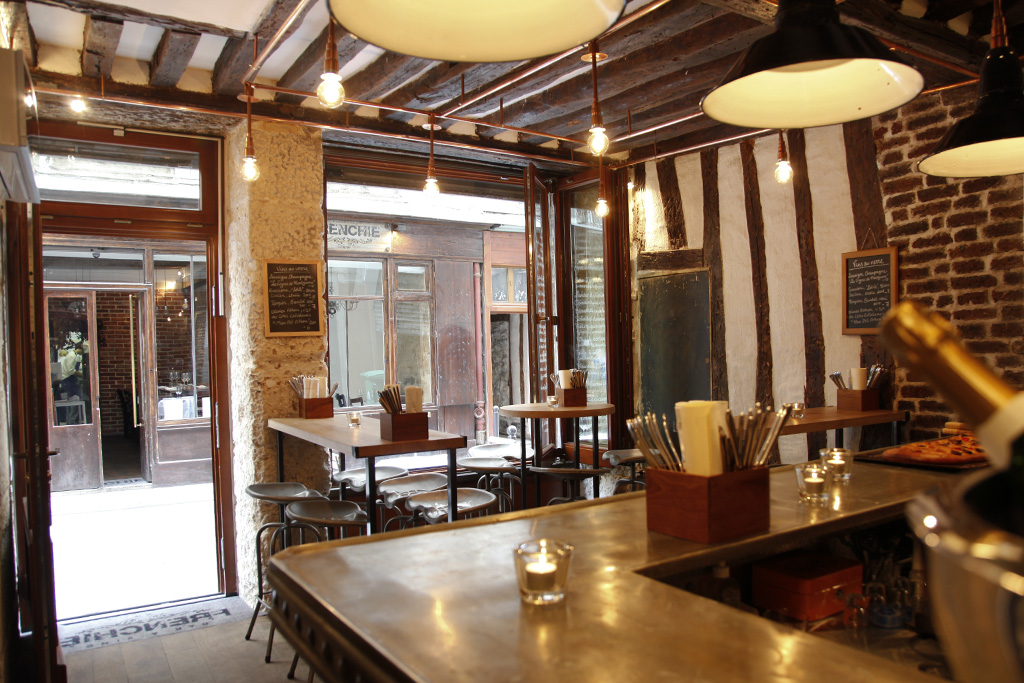
Frenchie today comprises a cosy wine bar on one side of the road, that is uplifted by its older sister (opened in 2009) – a gastronomic eatery of the same name just across, so the guests can peak from either to the other locale, scanning out what is happening over there. Usually, there is more action at the bar à vins. What connects them both is casual generosity and excellent products. They aspire to “the motto is to share and have a good time.”
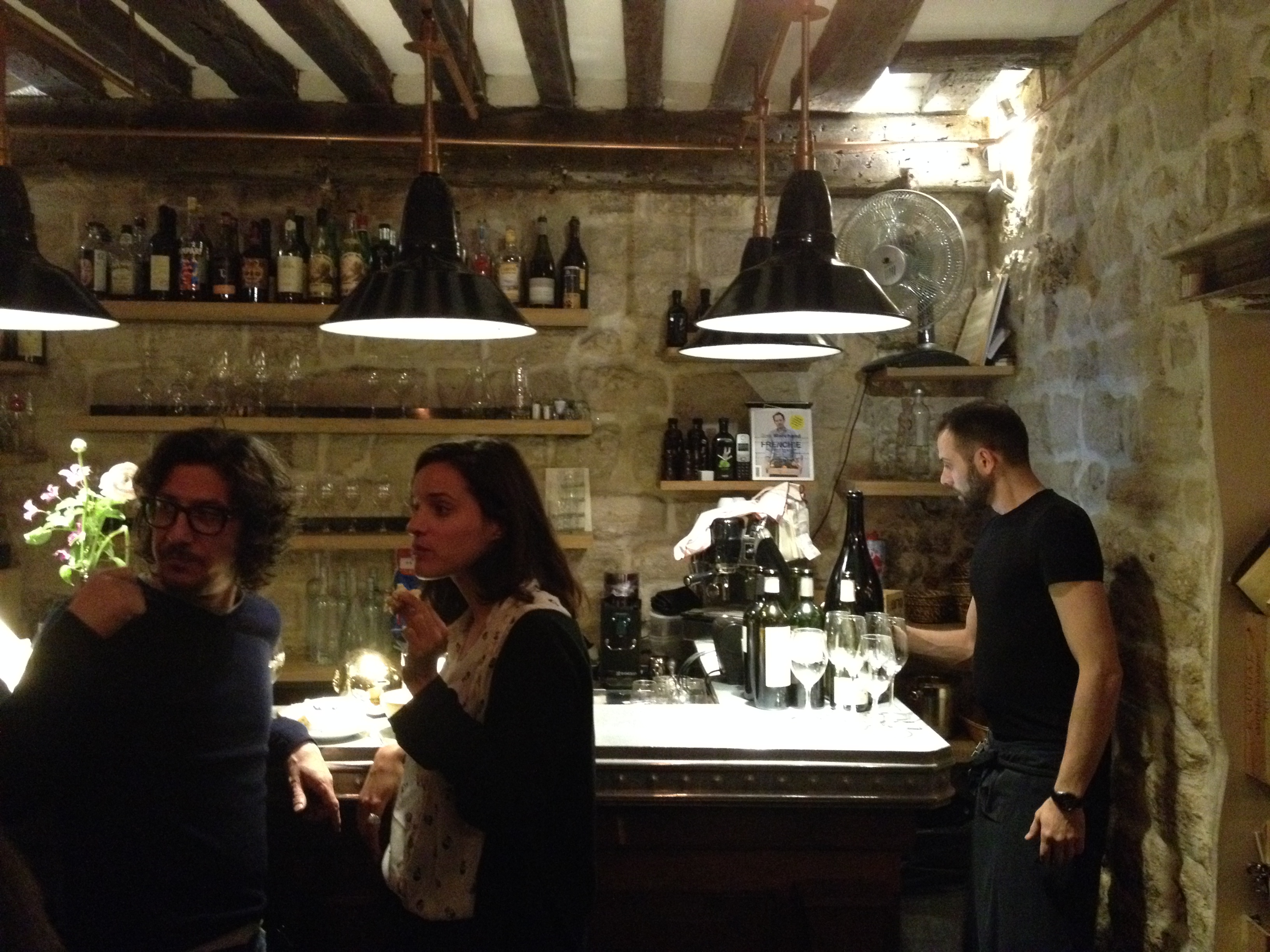
In their cosy, pocketed location near to the vibrant central Les Halles district, the restaurant, bar à vins and the third newest made-on-the-spot takeaway outlet, are hidden away from the voracious tourist hives. The small cobblestone-laid Rue du Nil, is now the hangout for the fans of ‘bistronomy’ and great wines.

Poured by the amiable Frenchie’s sommelier AURÉLIEN MASSÉ are mostly old world wines, particularly from France, but also some from New world (currently only New Zealand). Affordability is at the heart of the list. Most of the bottles do not surpass €50 price tag. The wine menu however peaks in these red beauties:
Vega Sicilia « Unico » 2000 (€490)
Beaucastel, Châteauneuf-du-Pape «Hommage à Jacques Perrin » 2001 (€680)
Château Mouton Rothschild 1998 (< €1.000)
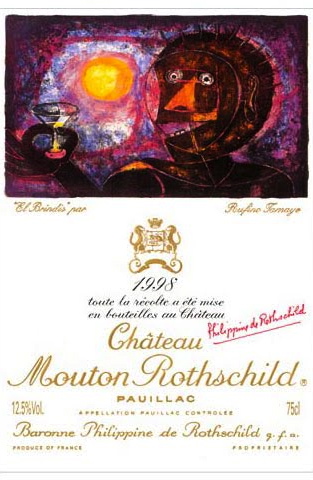
The list is constantly evolving though, so you should be open about your choices and let the knowledgeable sommelier advise you, just describe your preferences and taste and he will for sure surprise you with something enjoyable like he pleased us.
By his recommendation of a rare bottle of white Burgundy from Nuits-Saint-Georges Les Terres Blanches 2011 by Marchand Tawse, we learned that even this red-dominated appellation can strike a white gem. Made by a Canadian native Pascal Marchand, who adopted strict organic and biodynamic practices, this bottle is a less common blend of Pinot Blanc and Chardonnay showing mineral quality with crisp acidic grip strongly expressing the local soil.
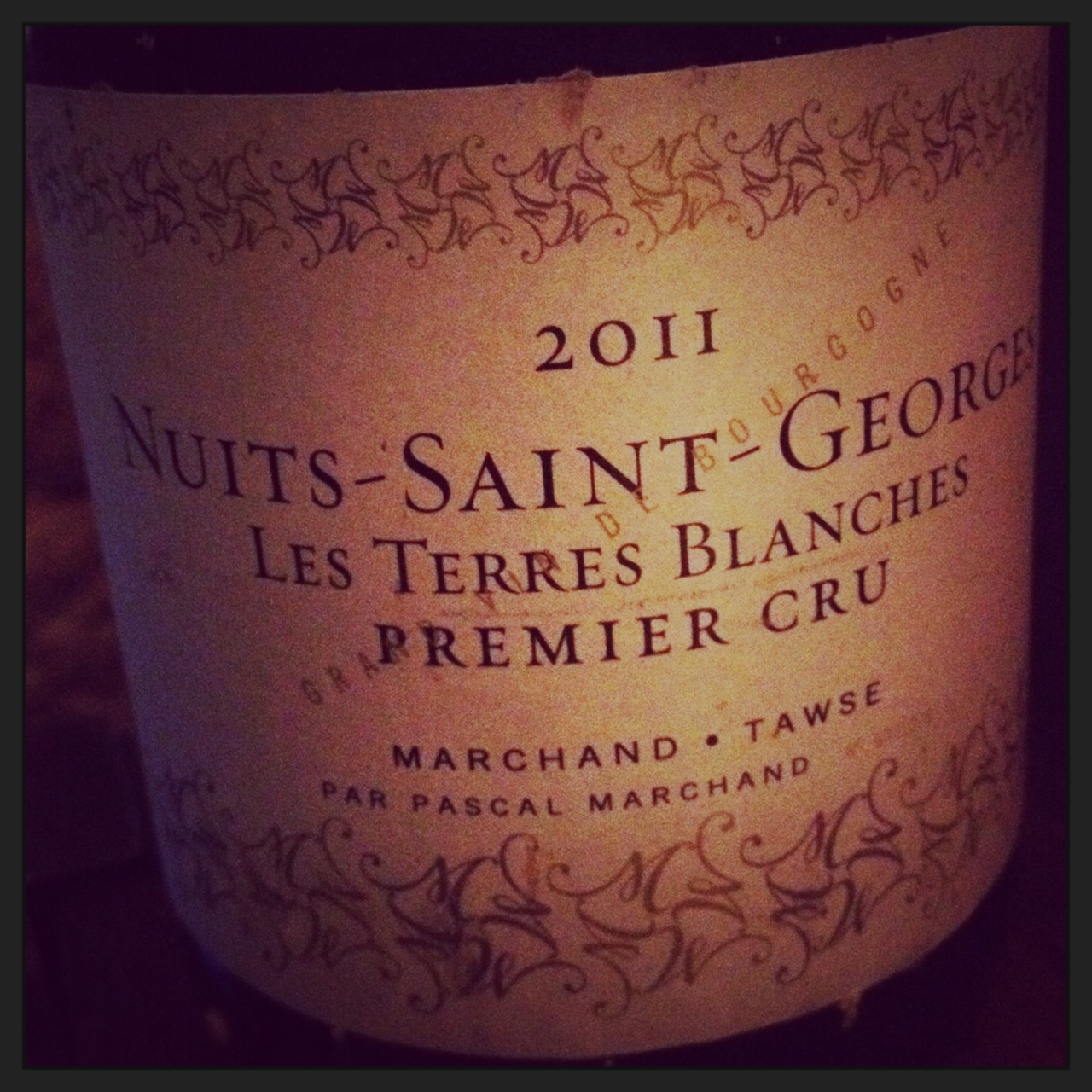
The cuisine at the restaurant and the bar has international influences of the well-travelled chef with experiences from London, Spain, Hong Kong and all-blending New York. He often combines French, Spanish, Italian and Asian ingredients in one dish. Cooking at the gastronomic restaurants of Jean Georges Vongerichten, inspired by the London’s River Cafe and his stint at the Gramercy Tavern in New York, accumulated in his first own venture back in his native country – the Frenchie in Paris. Excitment from contrast on the plate guides the chef’s creativity.
The ingredients come mainly from the popular chefs’s fresh food supplier Terroirs d’Avenir, that opened up on the same street so Frenchie always uses the superb vegetables, fish, meat and fruits sourced from its neighbor.
Terrines, homemade charcutterrie, a Foie gras in original variations inspired by the chef’s international experiences and starters like the adventurous Cream sea urchin from Brittany, starters using the Italian Burrata, and even en escape to Asia with plates inspired by various eastern ingredients. There are always some homemade pasta dishes, and daily changing fish, seafood and meat hearty dishes, that pair well with their wines.
The Rib-eye beef steak with french fries and homemade Bearnaise sauce is tongue-smackingly delicious and cries for a bold wine with lots of tannins and acidity to loosen up the weighty effects of the fat on your taste buds. The sauce is made to order fresh, so if you want more, order it ahead. It takes time to clarify the butter and emulsify it with the egg yolks in the bain-marie, then add some spark with a dash of white wine vinegar and finally bring the flavor to perfection with green herbs like shallots and tarragon.
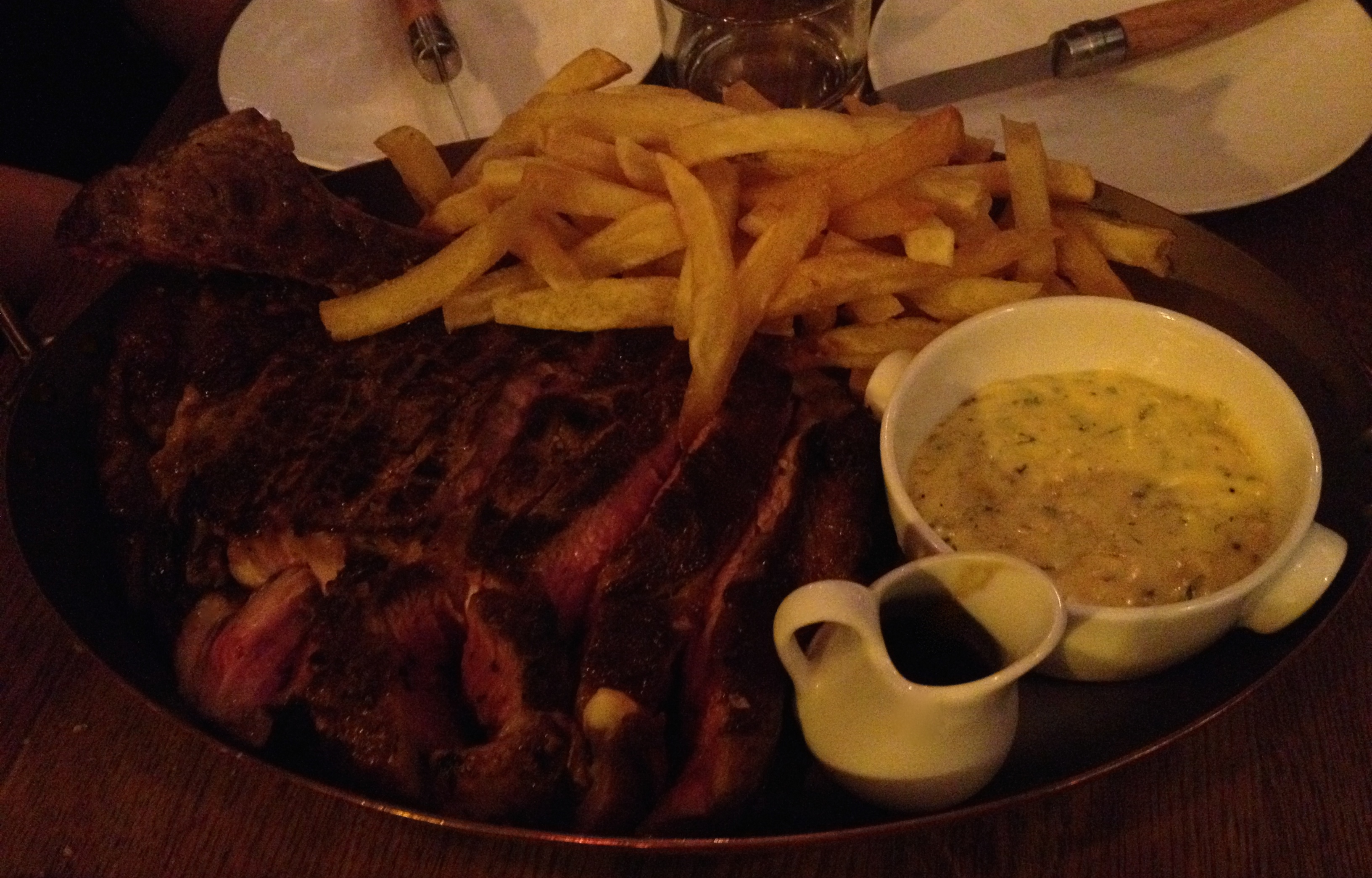
Curiously, much of the cheese comes from the UK and not from France. The chef’s English past comes to the surface once again in your cheese plate. Sourced from London’s Neal’s Yard Dairy, the cheeses are of the top quality and can be paired with wines on a request. Pecorino from Italy, Spanish Manchego and some French savory cheeses show up from time to time as well to please everyone. Cheese sometimes becomes a dessert when served with contrasting sweet condiments such as membrillo, honey comb or chutney.
Internationally inspired desserts like Honey ice cream with honeycomb, Chocolate pot with caramel butter and passion fruit or Amaretto panna cotta with avocado and chocolate stray away from the savory cheesy mode.
The wine bar is a younger, more spontaneous and approachable sister of the Frenchie restaurant, which still remains though the favorite choice crowning the local ‘bistronomy‘ trend.
If you need wine glasses for home use, Frenchie sells them at the bar as well. They really have it all; even a takeaway outlet on the same street with everything freshly made on the spot. Frenchie to Go is the youngest sibling to its two more grown-up sisters, that became such a hit in Paris.
Address: 5-6 Rue du Nil, 75002 Paris, France
Tel:+(33) 1 40 39 96 19
Henri Le Roux: French Master Chocolatier and Caramélier from Brittany
Henri Le Roux is a Master Chocolatier and Caramélier®. His masterful whipping and forming delectable caramels (the chewy and sticky bonbon-shaped sweet delights), manufacturing high quality single origin as well as house-crafted original chocolate bars, ganaches and pralines, deserves the attention of all sweet explorers eager to mark a palate-arousing shopping stop into their travel map.
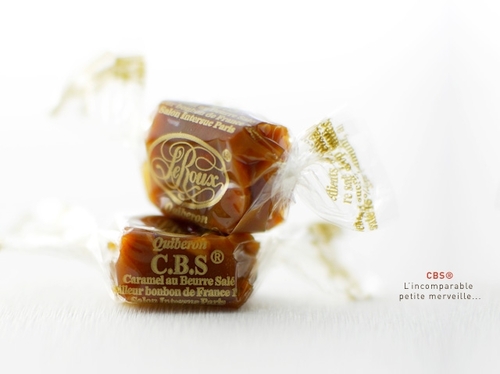
Whether you visit his new boutiques in Paris or head Northwest to Brittany, where his family business is located in the hometown of his wife – Quiberon and the factory at Landévant (opened in 2008 to cater to the high demand for his produce), you will be struck with his perfectionism. No wonder, the avid seekers of everything requiring an extraordinary effort – the Japanese consumers, welcomed his stores opening in Tokyo and Osaka.
The company was recently bought by the Japanese, yet the traditional hand-made production was kept intact and the chocolatier himself is still entirely involved.
Henri Le Roux is credited with the invention of the first real CBS (Salted Butter Caramel) so either of his boutiques are surely worth a detour to taste the original product. His muse was Brittany, where salted butter is ubiquitous. After three months of testing he came with a slightly salted butter caramel with an addition of crushed walnuts, hazelnuts and almonds for harmonious texture. A must try! The feeling of it melting densely, smoothly in your mouth is unforgettable for your taste memory.
After seeing many patisseries copying his inventions he decided to copyright a number of his products. Starting with the above mentioned CBS® in the 1980s, later his recipes for Truffe de Truffe®, Caramélier®, Bonsoncœur®, Force 8®, Louison®,and Ch’tou® were all protected from the eager copy-cats. Now, they must all come with their own preparations.
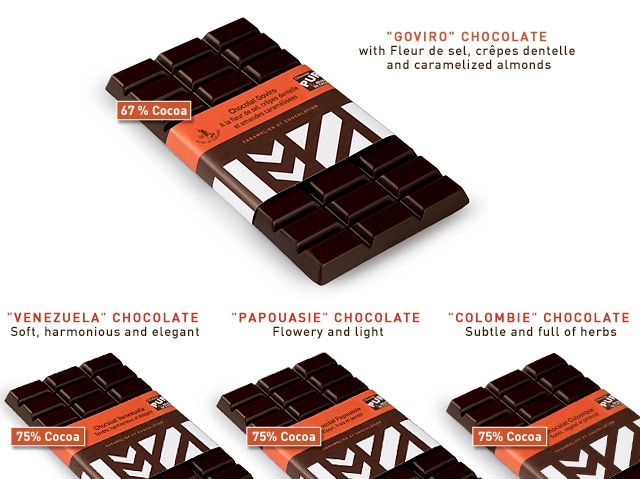
Ch’tou® has a bitter chocolate cover surrounding soft caramel containing butter and calvados from Brittany.
THE CARAMELIER® is a soft caramel toffee spread with a delicate structure and freshness.
THE BONSONCOEUR® is a fine chocolate spread with hazelnuts, pinch of Guérande salt and brown sugar.
Force 8® is a house blend of dark 80% chocolate bar with exotic, smooth and delicate spicy notes.
The Single origin chocolate bars I tried are:
Colombia 75% is pronounced, smoky, intense, with coffee aromas, but it starts with vegetal herbal and forest fragrance. Tannins are discreet until the astringent aftertaste and subtle acidity lets the tones form a full-length symphony of crescendoes and tuning down over and over.
Venezuela 75% is very balanced, intense and slightly vegetal. Exotic citrus fruits vibrate on the palate with a very long green wood aftertaste. While the rare Chuao from Venezuela is more burnt smoky like a cigar with wooden dryness and fresh green nutty taste. The village of Chuao is famous for its high quality Criollo cocoa beans.
Sâo Tomè 73% has refreshing acidity and fruity with vegetal aromas. Smoky background makes it more aromatic and complexity is enhanced by lime finish.
Papouasie (Papua New Guinea) 75% has light fruity character with dominant floral fragrance of lilies and orchids creating a dainty beauty with the delicate freshness of spring with warm sensations. Its rustic aftertaste surprises contrasting the previous sensations.
The house blends I tried:
Goviro is the signature blend with fleur de sel (sea salt) and crèpes dentelle and caramelized almonds. The deep 67% cocoa is cut with crunchy brittled almonds adding a toasty intensity and caramel sweetness, while thin crisp brittle pancake changes unexpectedly the texture. Fresh Guérande sea salt aftertaste lingers for a very long time in the bedazzled mouth.
Amer is another signature blend of secret origins 62% cocoa. It is fine, balanced, delicately sweet and delicate with nougat notes. Low tannins and not particularly pronounced acidity. Its smooth honey-like texture allows it to melt slowly with a gourmand nougat undertone.
Embruns mix of various origins with a dash of fleur de sel (sea salt from Brittany). The salt makes it mysterious as it plays hide and seek throughout the entire time the 67% chocolate is melting in your mouth. After the salt dissipates, fruity flavours show up, then earthy and deep structure with high acidity reveals itself last. It multiplies the powerful expression of this bar.
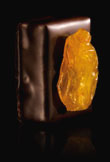
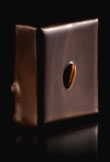
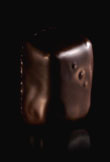
There are many ganaches (sweet chocolate cream filling) pralines (sweet almond paste) worth trying, but as each of us have different preferences, the best is to visit one of the boutiques and look for something that call you “try me”. I particularly like the Soizig (Buckwheat praliné and crumble) and the incredibly crunchy Praliné bouchée with generous hazelnuts from Piedmont and crêpes dentelle coated with dark chocolate. (In French “Bouchée” means mouthful).
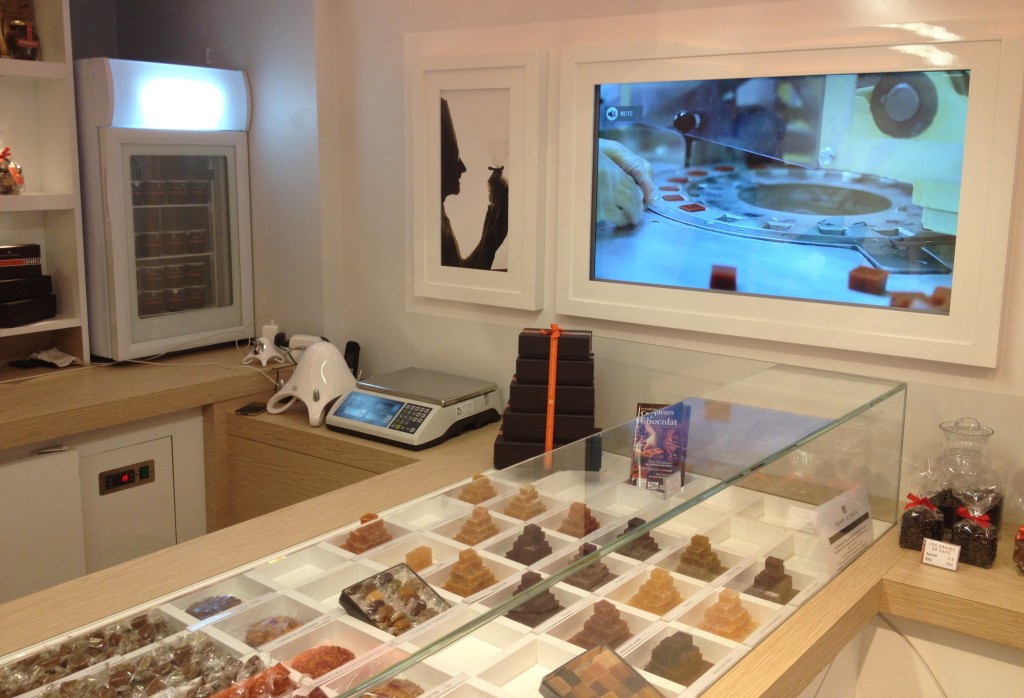
Le Roux himself advises his consumers on how to select, keep and enjoy high quality chocolates at their best:
- Always choose a chocolate with a shiny “coating”, which is a guarantee of quality.
- Don’t keep chocolate in the refrigerator. It is better to keep it at a cool room temperature (between 16º C to 18º C)
- Keep chocolate away from damp. It is its worst enemy. A watertight cover is always advisable.
- Do not place it near strong-smelling food or other products, which could, in the long term, alter the taste of the chocolate.
Well, as a chocoholic who stores chocolates in the fridge, next to onions, cheese and the leftover saffron risotto, I learned a lot!
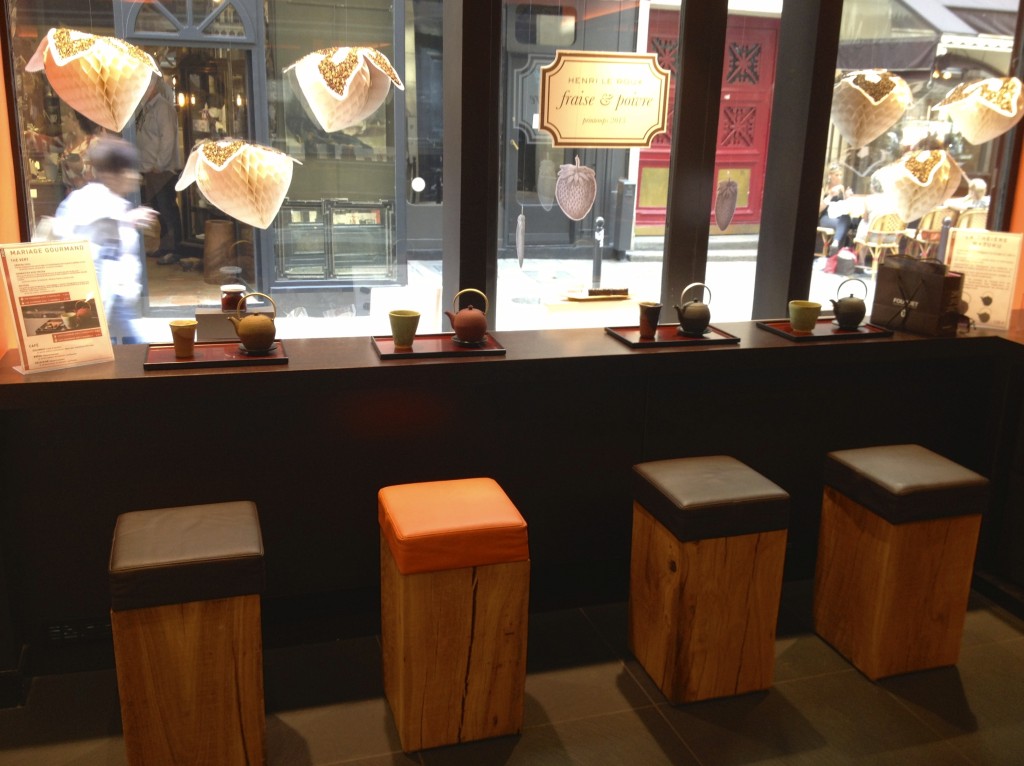
His creativity does not know boundaries, and he decided to pair my two favourites – tea and chocolate at some of his flagship boutiques. There are various combinations worth exploring and you can sit down, watch the passersby and contemplate the flavours marrying together in your mouth.
Henri Le Roux boutiques:
18 rue de Port Maria, Quiberon, France
Factory: ZA Mané Craping, Landévant, France
Tuesday to Sunday: 10:30 – 19:00
In Paris 1 rue de Bourbon-le-Château, 6th Tues-Sat: 11:00 – 19:30; Sun & Mon: 11:00 – 14:00 & 15:00 – 18:30;
24 rue des Martyrs, 9th Tues – Sat 10:30 -14:00 & 15:00 – 19:30; Sunday: 9:30 – 14:30; Closed Mon.
Shops in Japan and other points of sales in Europe are on their website.
Richart chocolatier: savour the year's seasons in cocoa-coated Petits Richarts
Richart chocolatier pioneered a number of delicious cocoa-based indulgences even on the highly competitive gourmand scene in Paris. Known mostly for his adventurous Les Petits Richart reflecting the year’s seasons, the grandson of the maison Richart’s founder refreshed the colourful repertoire. Adding the bubbly “Infuzzz” and in tune with the modern demand for provenance distinctive produce are the highly refined “Ultrafine Dark Chocolates”.
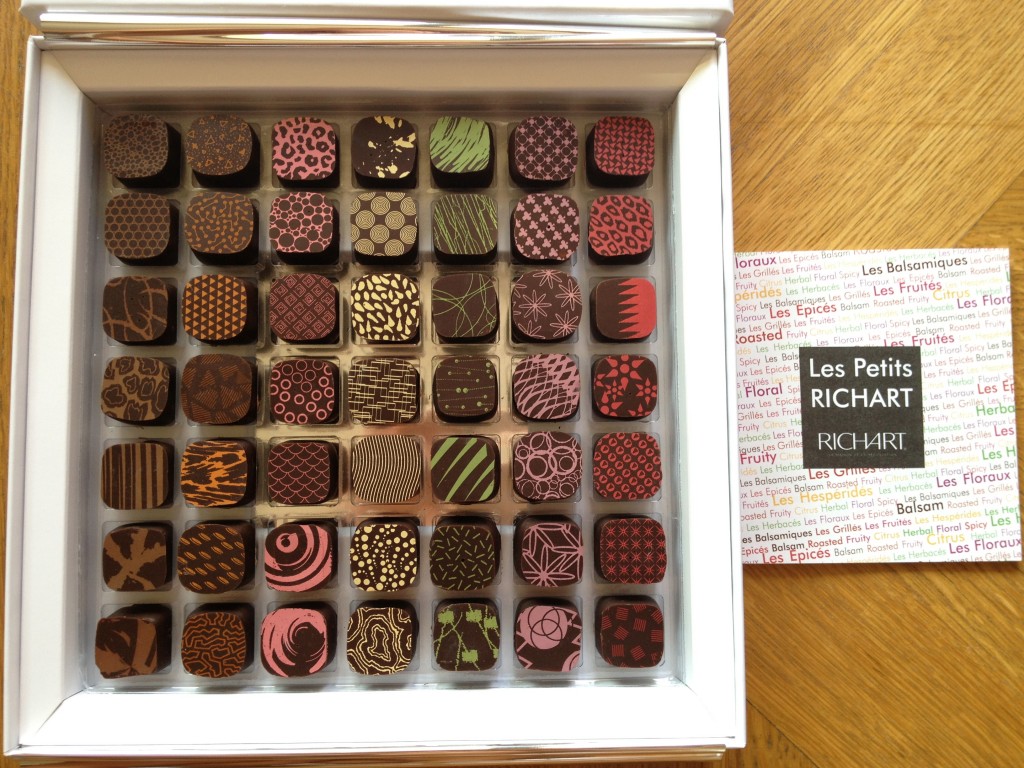
Michel Richart is a true master chocolatier like his father, who became legendary in the French confectionery sphere for his innovative sweet pieces of mini art. A gustatory diversity and attention to quality of the purest ingredients sourced from the most suitable plantations, farms and orchards around the world are the centrepieces of the family chocolaterie.
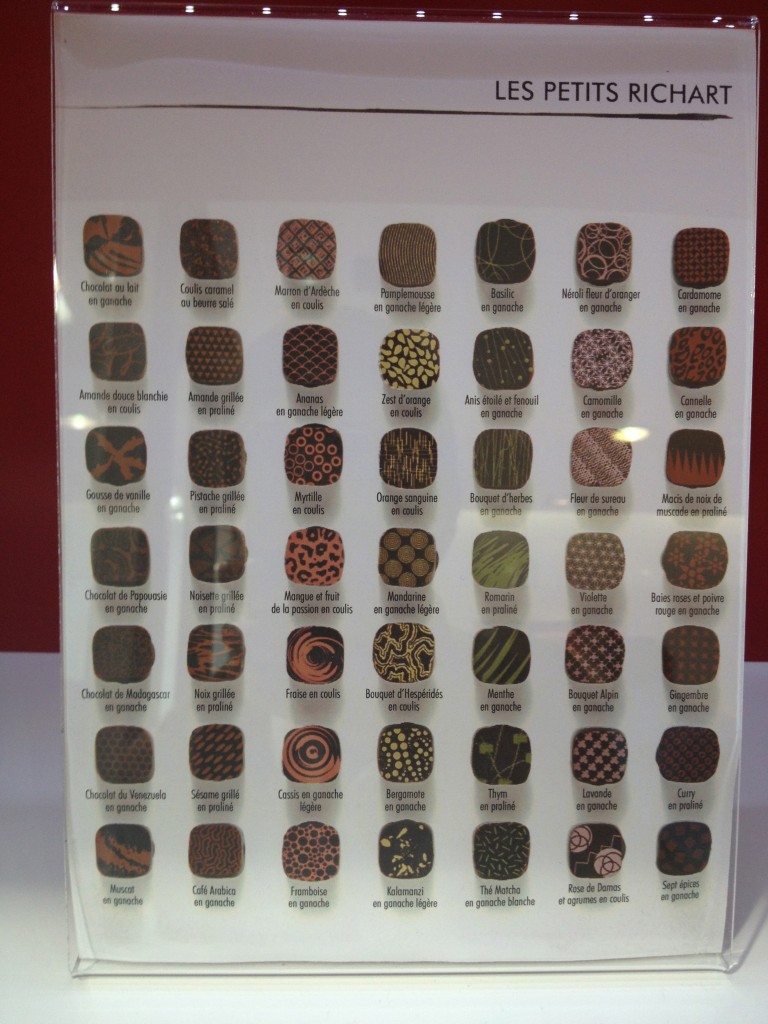
The philosophy of La Maison RICHART dwells in: “Satisfying every moment in a day for tasting, the collections are dedicated to all ‘chocolate addicts’, who from morning till night and throughout the days of the year, indulge in their favorite pleasure.” Hence, the chocolates keep their velvety soft coat but everything under it changes as if a fashion designer created a new collection reflecting trends, but brought it alive with his personality and changing seasons.
The signature product Les Petits Richart is a pleasure without guilt as each tiny chocolate bonbon weighs 4 grams and contains 15 calories only. RICHART removed the excessive sugar and kept the focus on the most delectable ingredients wrapped inside a rare 73% Venezuela Criollo dark chocolate shell. The flavours were divided into seven Richart Aromatic Families: roasted (all nutty and coffee-based, but the toasted sesame praline is outstanding!); balsam (bleached almond coulis, vanilla bean ganache underline the fine chocolate coating); citrus (calamansi and grapefruit coulis are delicately refreshing); fruity (Ardèche chestnut coulis is surprising); floral (Damask rose with citrus coulis is delicately exotic); herbal (basil, rosemary and bouquet of herbs pralines transfer your senses to the garden); and spiced (the curry, cardamom and particularly the muscat nut are exquisite eastern beauties).
Richart was one of the first chocolate makers attaching a Tasting Guide to each of his collections in order to create “special tasting moments” such as:
- The Chocolate Ceremony ® for the passionate about the “art of tasting”
- Nibbling when tempted
- Celebrating
- At the table for sharing
- Pairing chocolate with black or herbal tea, coffee or wine.
- Dreaming for the knowledge and experience seeking gourmets
For the ultimate luxurious chocolate indulgence is The Burlwood Vault that is equipped with temperature and humidity gauges to keep your chocolates in the best tasting shape.
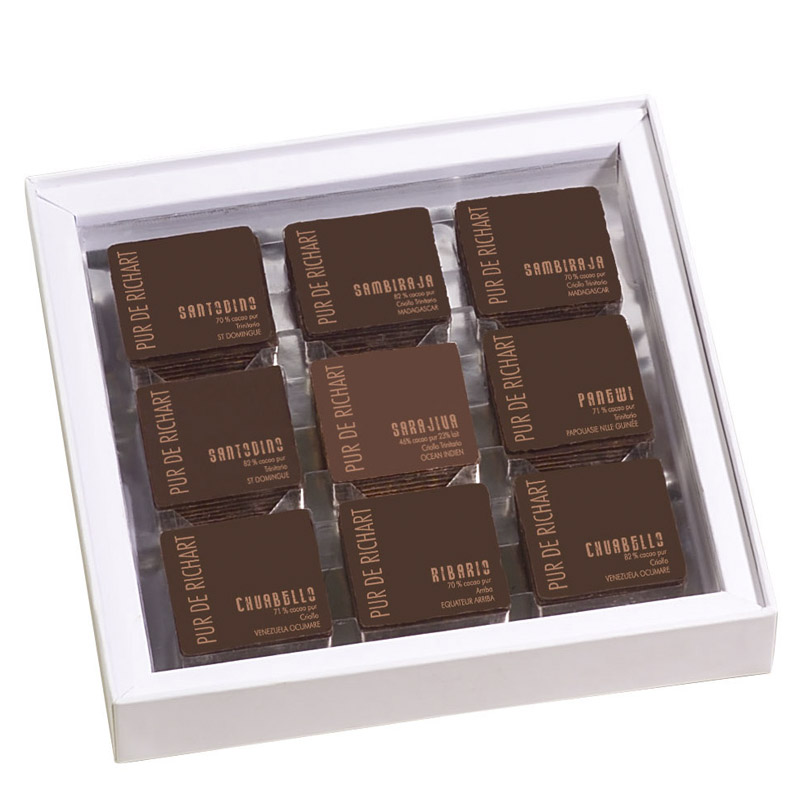
The Maison Richart crafts also pure chocolate bars. The current trend of single origin chocolate bars has already settled comfortably in Paris, and even Richart makes gourmet dark chocolate bars, from 70% to 100% cocoa content. The Venezuelan “Chuabello” made of 71% Criollo beans typically displays woody bitterness that grows exponentially, roasted dried fruits and roasted cocoa bean add to complexity. The bar is balanced by a slight sweetness. Dark chocolates from Ecuador, Dominican Republic, Madagascar, Sao Tome and Peru complement the highly charged chocolate collection.
I love to nibble and dream when savouring the Ultrafine Dark Chocolate squares. With different percentages, origins, and even bean types all written on each little square I understand and ponder over what I am eating, which gives me an added pleasure from tasting. Like Richart chocolatier the Swiss chocolate maker Laderlach also makes similar grand cru single origin chocolate thins.
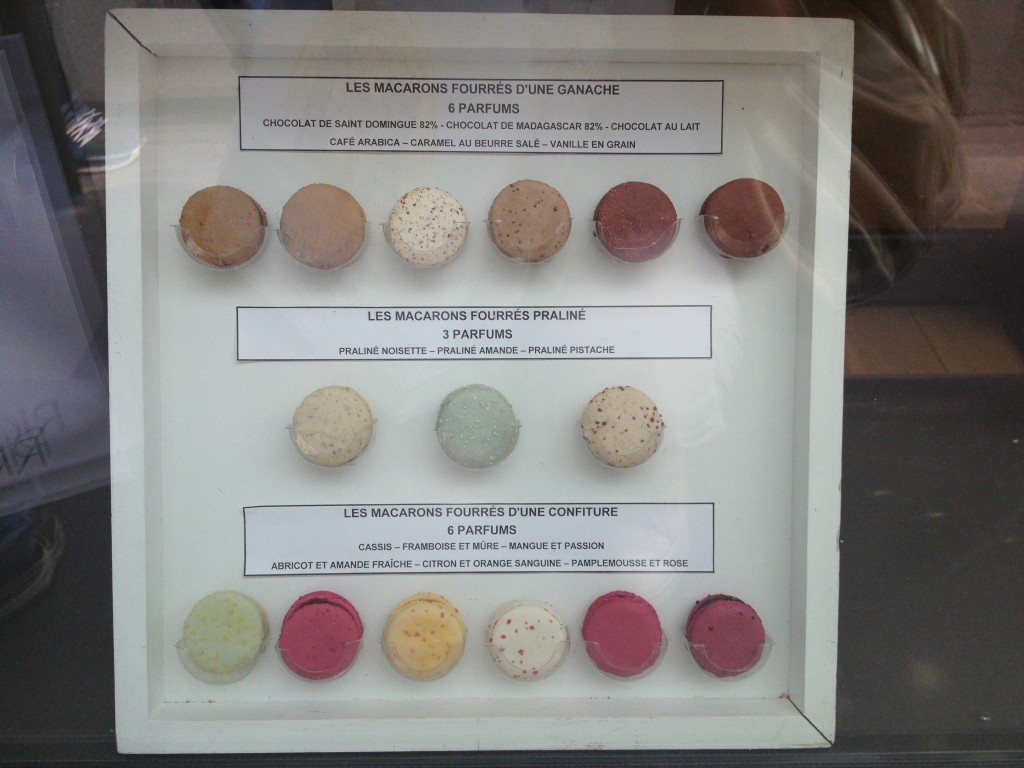
For special occasions a personal message inscribed on a thin dark chocolate (made of 73% pure cocoa) will make any receiver of such a tasty gift happy. These “Message plaques” can be customised to your needs, but “Happy birthday” and “Thank you” are ready available.
Macaroons are perhaps the most representative pastries of France. Richart has concocted his own preferred perfumes that change seasonally.

The chocolatier has his book called ” Chocolate mon Amour” [Chocolate-my love] in which he discloses his personal affair with chocolate and shares with the readers his well-tried tasty recipes.
27 rue Bonaparte, 75006, Paris, France
258 Boulevard Saint-Germain, 75007 Paris, France
Three locations in Lyon; outside France in South Korea and Puerto Rico.
Mon-Sat: 10:00 am – 7:00 pm; Sun closed.
+33 1 45 55 66 00
Chef Georges Blanc: keeping the Bresse chicken rolling the high game
The three Michelin chef Georges Blanc is devoted to tradition as he believes that diners appreciate the loyalty to one’s culinary roots. Looking at countless successful Italian trattorias lead by families sticking to old recipes, appreciated by many customers eating at these often basic places, one must agree that experience tried by generations works. The service at Georges Blanc in Vonnas goes a bit further than a casual mamma’s trattoria and the food is also more pompous.
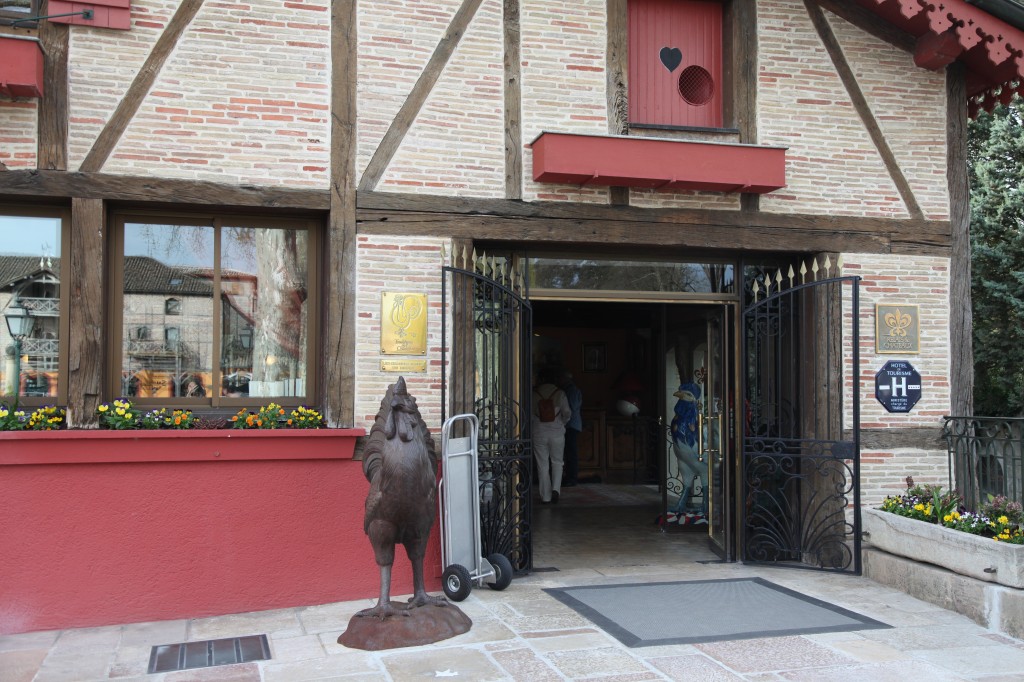
Blanc’s philosophy combined with his accent on seasonal ingredients and by nature-inspired innovation of the French nouveau cuisine at his gastronomic restaurant was rewarded with three Michelin stars and kept them for over thirty years! No wonder that Blanc is one of the most respected chefs in France.
“La tradition revisite en permanence au fil des saisons”
[Tradition revisited in the course of changing seasons]
G.Blanc

The uncrowned king of Vonnas, a small town south of Burgundy, the chef Georges Blanc is a man who wanted to be a pilot when he was boy, yet his mother’s cuisine and culinary education lead to a very different career. He might still though bring many of his clients to the sky of tasty pleasures with his cooking.
He cooks his mother’s recipe for the famous chicken exactly as she did almost half a century ago. Intriguing is the fact that instead of flying to foreign countries, he stayed at home and does not sow restaurants bearing his name all over the world as many of his star-colleagues do. In an interview I asked him why, and he confessed: “A gourmet restaurant signed by a Grand Chef requires his permanent presence and an ongoing commitment. Beyond the quality of the plate, he has to make something happen. This little extra something only happens thanks to his physical presence and the intangible marriage of the atmosphere with his guests.” I cannot more agree with him. Blanc now is involved with a number of restaurants around France, all bearing his spirit and so their are grouped as “L’Espirit Blanc“.
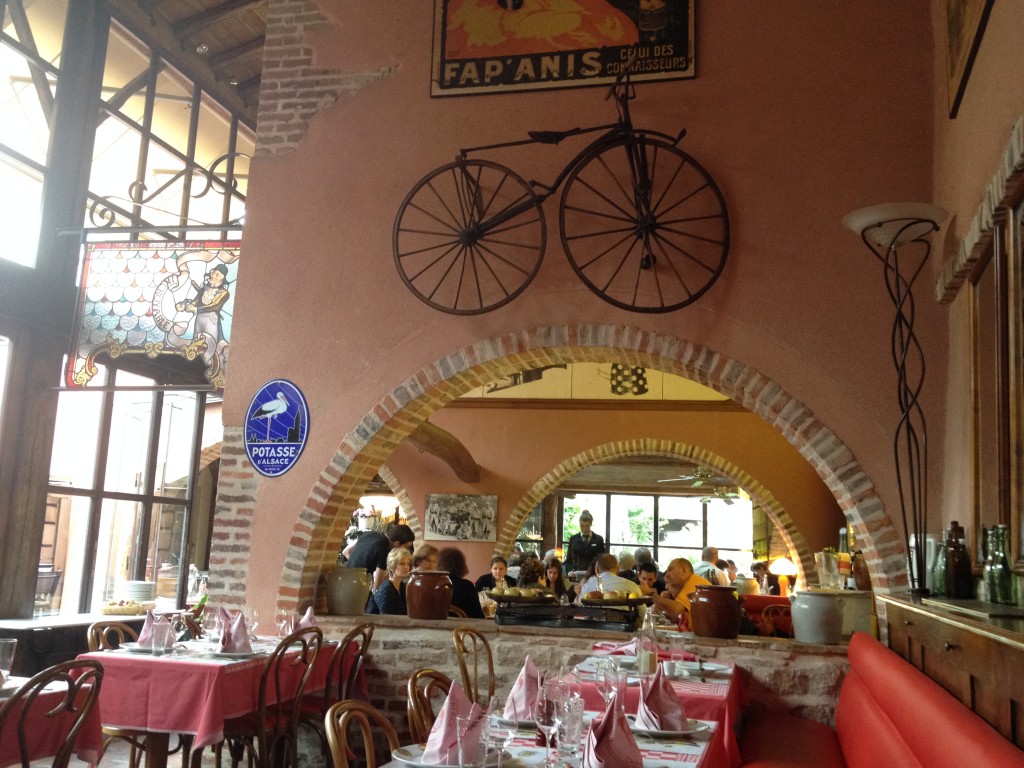
His bow to tradition and his culinary heritage is keeping a more affordable casual brasserie alongside his high-end restaurant in Vonnas. At both the Bresse chicken – with its own AOC (Appelacion d’Origine Controlle) can be ordered, so one doesn’t need to endure the lengthy procedures that are attached to a three-star restaurant. The Bresse chickens are free range and raised on natural herbal feed.
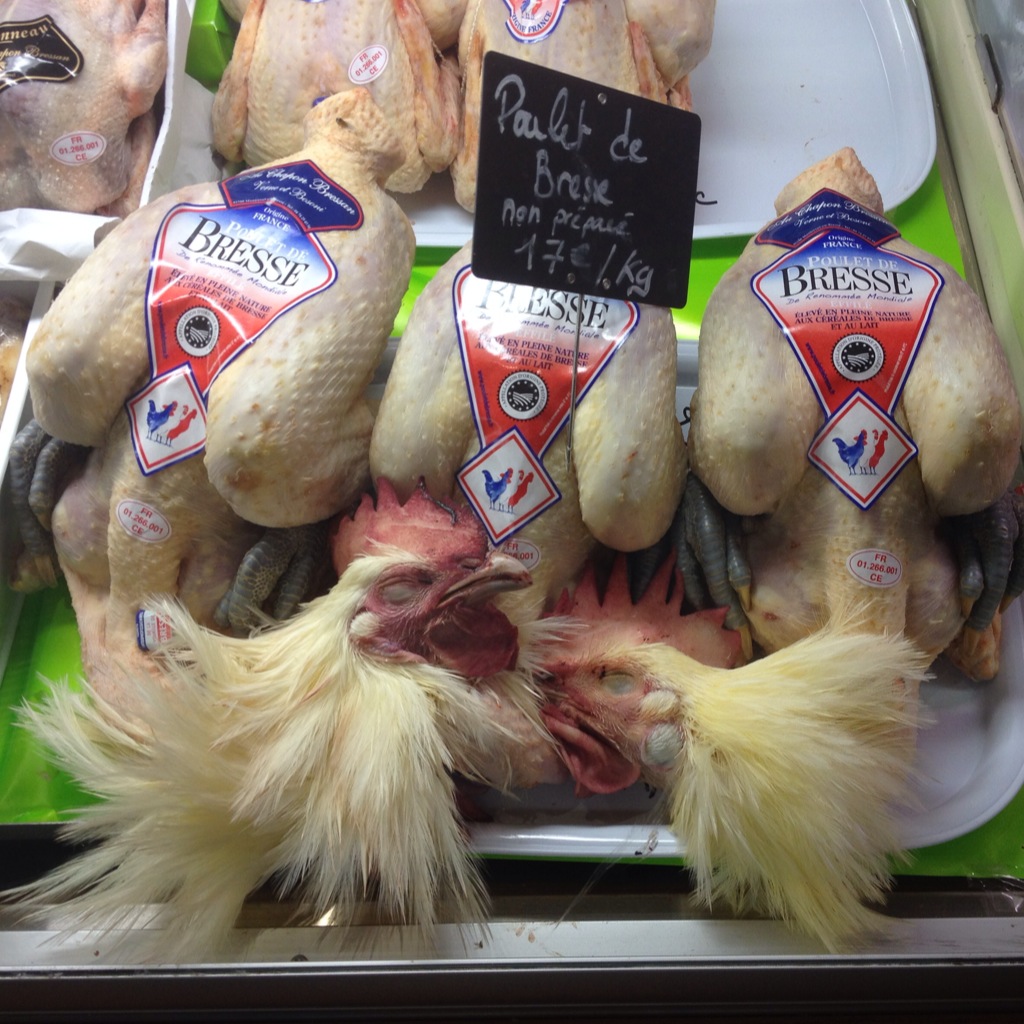
The chef’s preferred dishes are simple. He enjoys whatever is in season – the grilled chicken from Bresse with mashed potatoes and lobster from Brittany are his favourites. At his casual brasserie I always relish the succulent Frogs’ legs (grenouilles in French) that are combined with a rich butter sauce and a generous sprinkle of herbs bursting with natural flavours.
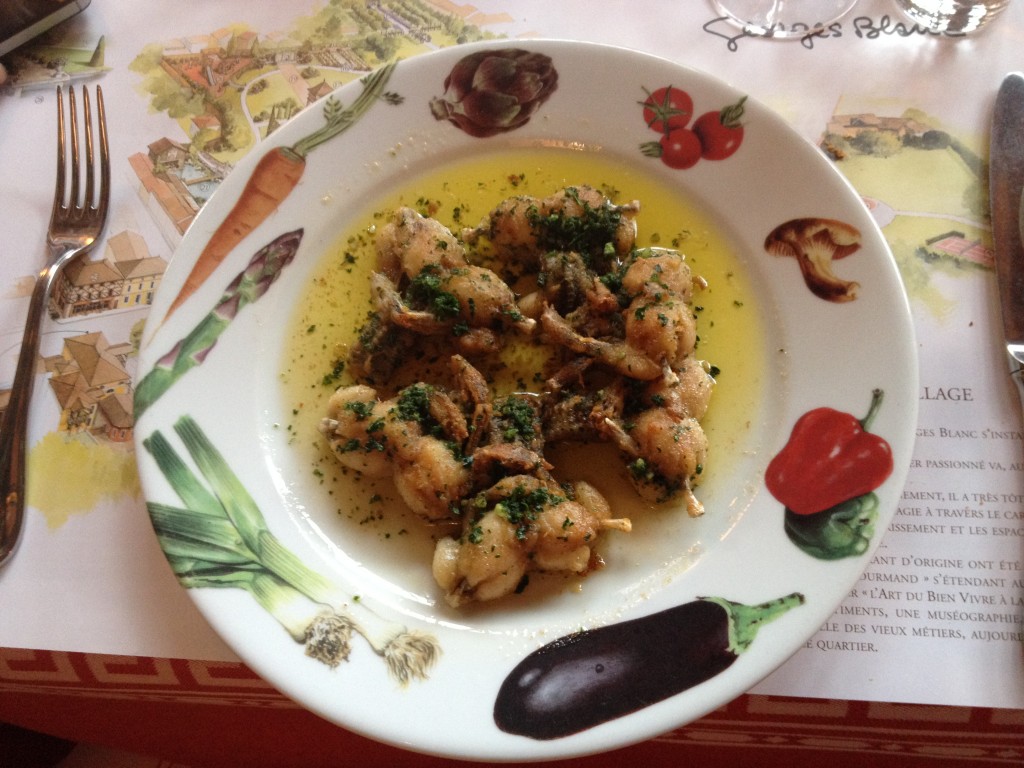
His gastronomic restaurant and a cosy Relais Châteaux hotel in the same building allow traveling foodies a safe trip, since there is no need to drive anywhere after consuming wine generously. The village concept was born over 40 years ago to reflect the French “l’art de vivre” [the art of living] in its exquisite gastronomy, combined with a healthy lifestyle as a spa, swimming pool and rural environment surrounding the premises. You can also buy the fresh chickens alongside pastry, chocolate, jams, and other delicacies at the gourmet parlour next to the brasserie. With all these options, Vonnas under his patronage became a heaven for food aficionados coming here from all corners of the world and the flow of hungry tourists never stops.
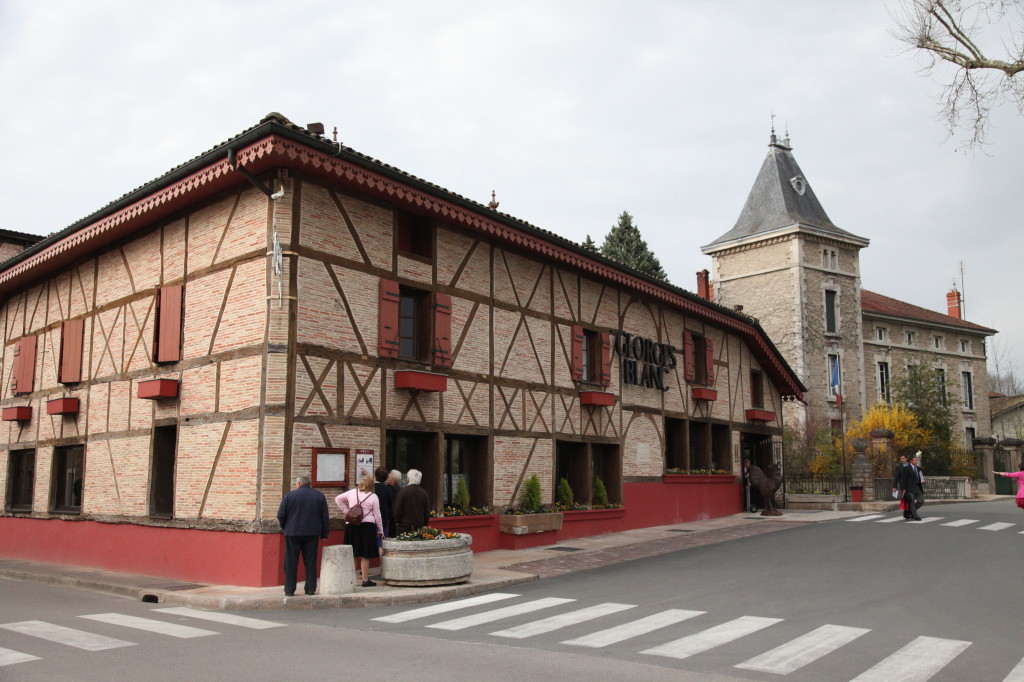
A perfectly tended vegetable and herbs garden supplies both of his kitchens. The recent hype of molecular cuisine was never appealing to the chef, who relishes in “rational creating“. It is a cuisine that comes first and then it can possibly surprise. So, no tricks, explosive or evaporating sauces or other gimmicks suiting a magician’s show, not a chef endeavour in the kitchen.
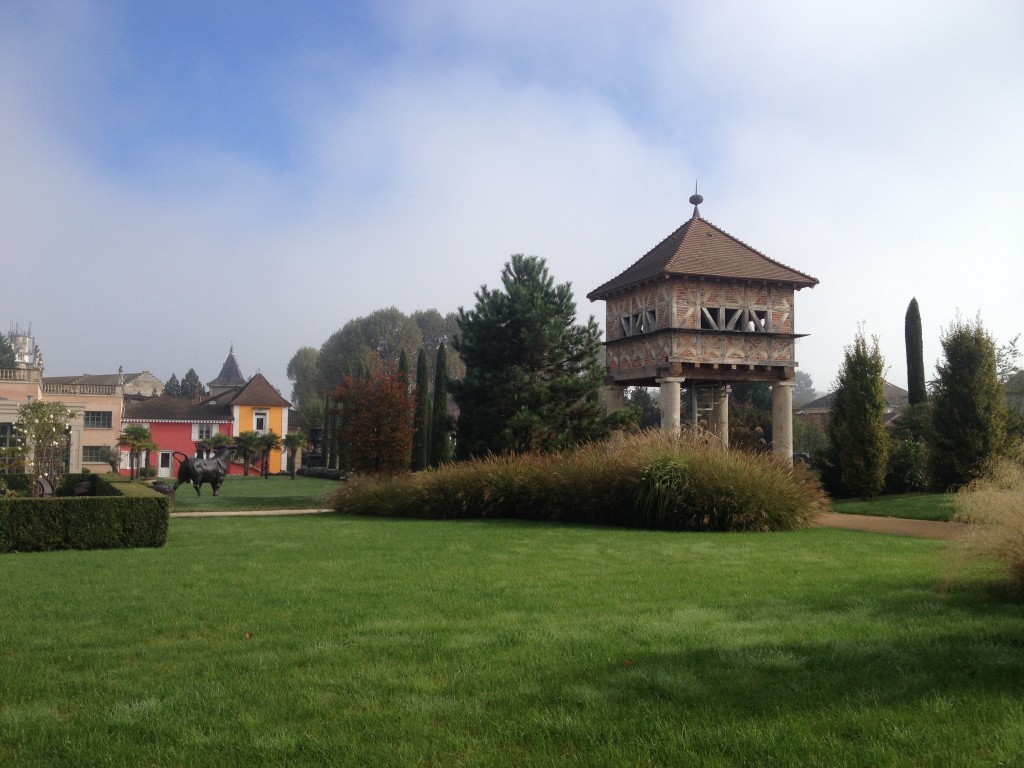
Food and wine go together in France. The chef Georges Blanc owns a vineyard in Burgundy and his wines are also available at all of his restaurants. They make for an excellent aperitif at the bar before the dinner. Himself, he loves Chardonnay and calls it “the king of white grapes“. Blanc like most well-known chefs is also an author of many culinary books, from which the most acclaimed “La nature dans l’assiette” [Nature on the plate] has been translated into five languages and became a point of reference for many aspiring as well as established chefs.
Hugo & Victor Paris: bringing chocolate, tea and wine together reflecting changing seasons
Hugo & Victor’s like Victor Hugo’s works are irresistible, some are avant-garde and unquestionably creative. Like the later, the famous French writer Victor Hugo living on Place des Vosges, Hugo & Victor settled in Paris and let their creative juices flowing. The spherical chocolates, pralines and ganaches of Hugo & Victor are presented in “Writer’s notebook” (sold from 6 to 105 pieces in this originally shaped box) as a reference to the literary past of the Parisian Left bank. But that is not all – Hugo Caramel, Jorge Amado (a chocolate & vanilla cake), Hugo Combawa and Saint-Honoré Chataigne, that are among the signature pastries, will tease not only your brain but also your palate. The name captures the spirit of the pastry & chocolate brand in the innovative “Hugo” pastry, aiming at deconstructing traditional pastry, and in the comfort seeking“Victor” treat, bringing you back to your childhood yearnings.
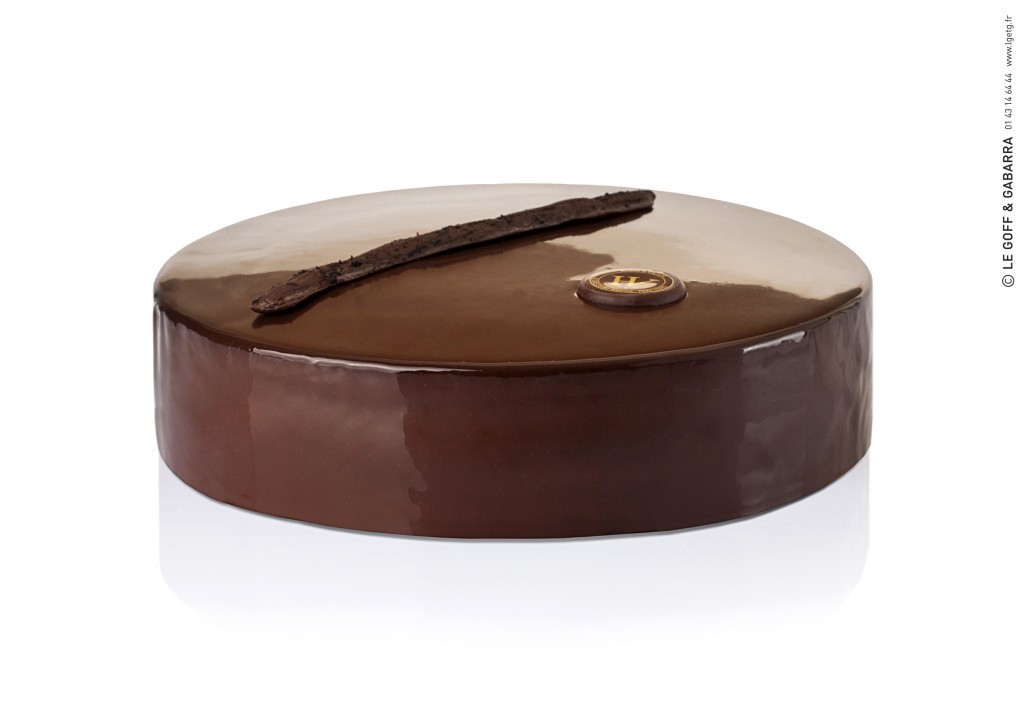
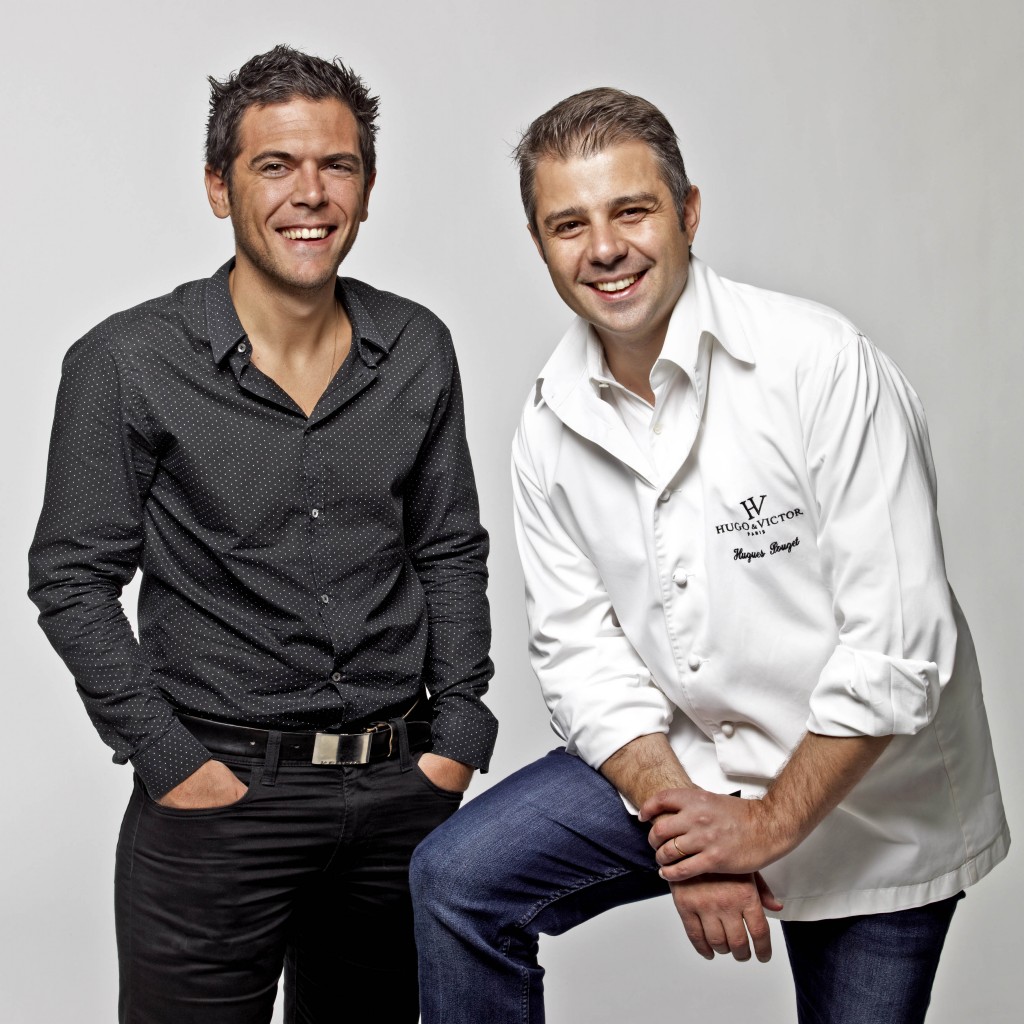 The creators are two childhood friends from Hyères, South of France. Hugues Pouget and Sylvain Blanc reunited so they could overturn traditional pastry codes. Hugues Pouget was made EXECUTIVE PASTRY CHEF at Guy Savoy, just after winning his third Michelin star. The following year, he won the French Dessert Championship. Traveling to Singapore, Shanghai, Japan and Brazil, tasting and savouring new flavours, opened his eyes to the new possibilities. Sylvain Blanc, developed the Cacao Barry brand in Europe. In 2010, the two of them assembled their experience and opened Hugo & Victor.
The creators are two childhood friends from Hyères, South of France. Hugues Pouget and Sylvain Blanc reunited so they could overturn traditional pastry codes. Hugues Pouget was made EXECUTIVE PASTRY CHEF at Guy Savoy, just after winning his third Michelin star. The following year, he won the French Dessert Championship. Traveling to Singapore, Shanghai, Japan and Brazil, tasting and savouring new flavours, opened his eyes to the new possibilities. Sylvain Blanc, developed the Cacao Barry brand in Europe. In 2010, the two of them assembled their experience and opened Hugo & Victor.
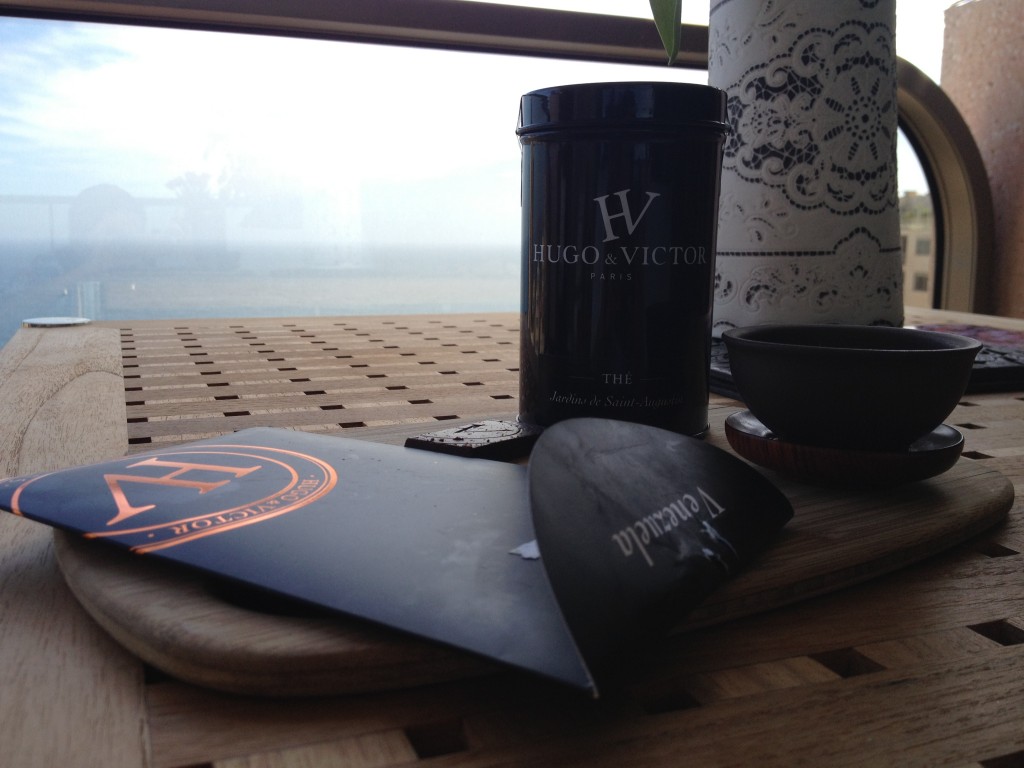
Hugo & Victor use top ingredients such as vanilla, sourced from Alain Abel, Tahiti-based producer renown for the quality of his beans grown on three distinctive terroirs: Bora Bora, Raiatea and Tahaa. These beans can age longer than other vanillas enabling them to reach a grater maturity imparting aromas of cacao and caramel. Further, Hugo & Victor has its own plantation of kaffir lime, a rare exotic citrus fruit, and verbena grown in South of France. Pairing their pastries and chocolates with various beverages such as tea and wine is close to the founders’ hearts. Frédéric Béal, well-known sommelier, has selected wines to match, but Hugo & Victor also works with Le Domaine de la Bégude in the South of France, which does not use any pesticides or fertilisers in their production of grapes.
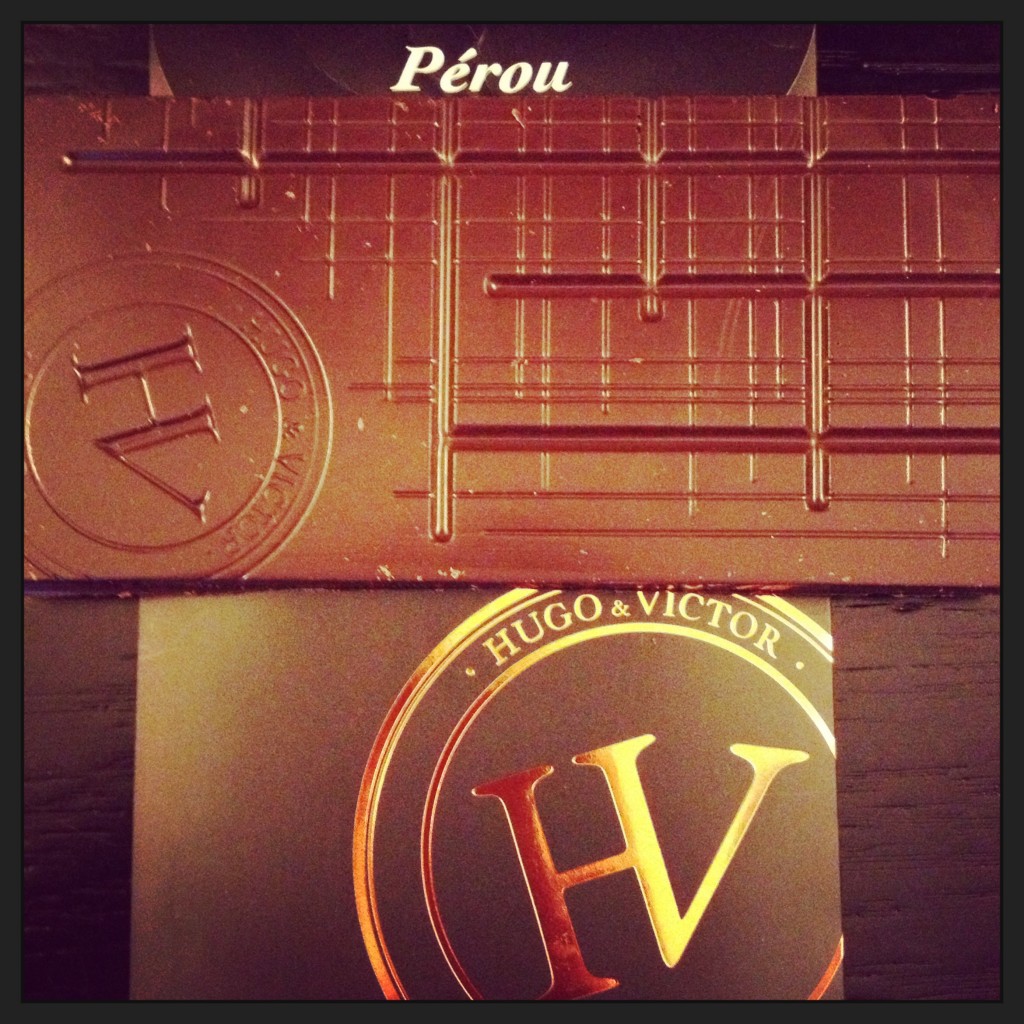
Chocolate and tea pairing at Hugo & Victor
While shopping at the boutique I was recommended to pair the single origin Dark Chocolate from Venezuela (75%cocoa) with Hugo & Victor black tea from China ‘Greysha’ or the green tea-based blend Jardin de Saint-Augustin – Sencha & Gunpowder green teas perfumed with mint&rose with rose petals. I went for the Jardin de Saint-Augustin. The chocolate’s delicate and creamy texture lively with high acidity, citrus fruits (lemon, grapefruit) and shy raspberry aroma was changed by the full and astringent tea. The raspberries showed off while the citruses were tamed reaching a nice balance of flavours. Other teas blended by H&V are Pétale de Pamplemousse (black Chinese tea with grapefruit peel), Aux sources de Greysha (black Chinese tea with bergamot, orange, cornflower petals and orange peel), Éclosion de Fruits rouges (green Sencha tea with currants, strawberries, raspberries and cherries), and Coeur de Montezuma (white Chinese tea with mango and papaya). The dark chocolate bars, especially the single origin chocolates, demonstrate the quality of the raw ingredients, while the creations of tablets made with grapefruit petals, mendiants and other ingredients by the duo show their mastery of craft. The 75% cocoa-containing bar from Peru is well-balanced, smooth on the palate and delicately embalms your tongue with sweet honey-like sensation. It is elegant with acidity and tannins in the equilibrium so they do not bother and make the chocolate pleasant for anyone who does not like sharp, robust and too sugary flavours.
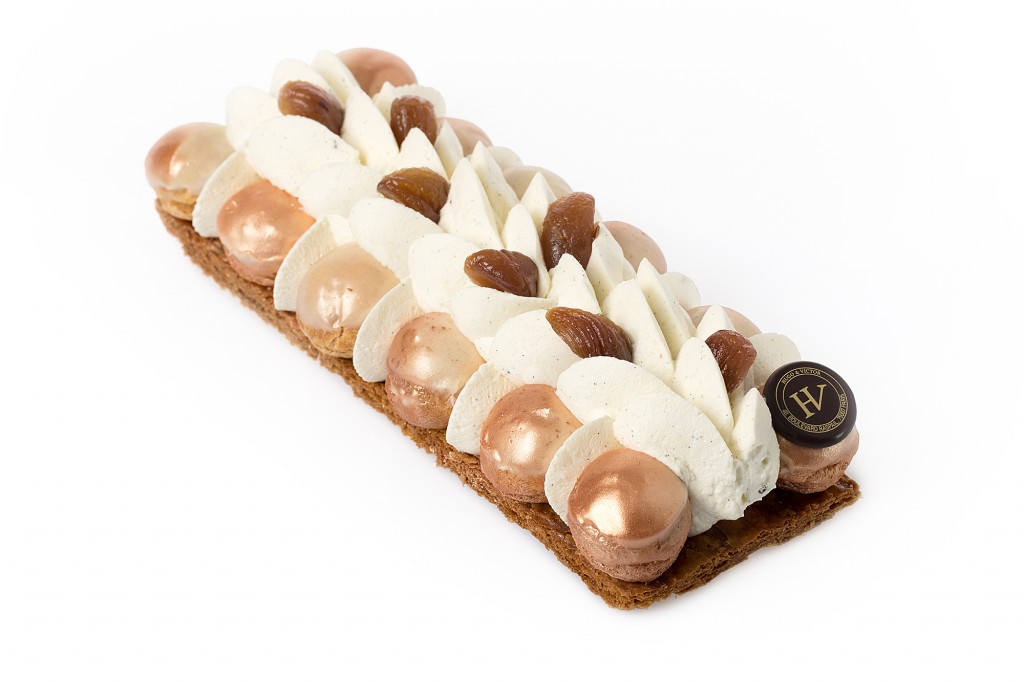
Following seasonal availability and freshness of ingredients is not just a revived trend of recent years, it had always been a necessity of the past. Yet, changing ingredients in our diet is also reasonable as our palates appreciate different things with changing seasons. Hugo&Victor creations are overwhelmingly based on the philosophy of the seasons.
Some ingredients are timeless – “LES INTEMPORELS“, they are always available fresh throughout the year. These are the star flavours at Hugo & Victor: chocolate, caramel and vanilla from Tahiti.
Whereas, the other five transient flavours display their mighty only when they are in SEASON:
- Citruses & exotic fruits: Pineapple, bloody orange, litchi, passionfruit, lemon.
- The spring: Lemongrass, pistachios, coffee, cane sugar, passionfruit, rhubarb.
- The orchard fruits: Strawberry, cherry, raspberry, blueberry, verbena, apricot and peach.
- The Indian summer: Verbena, figs, almonds, combawa, mirabelle plums, pear, grapes.
- The autumn: Combawa, pomegranate, tangerine, chestnut, apple and lemon.
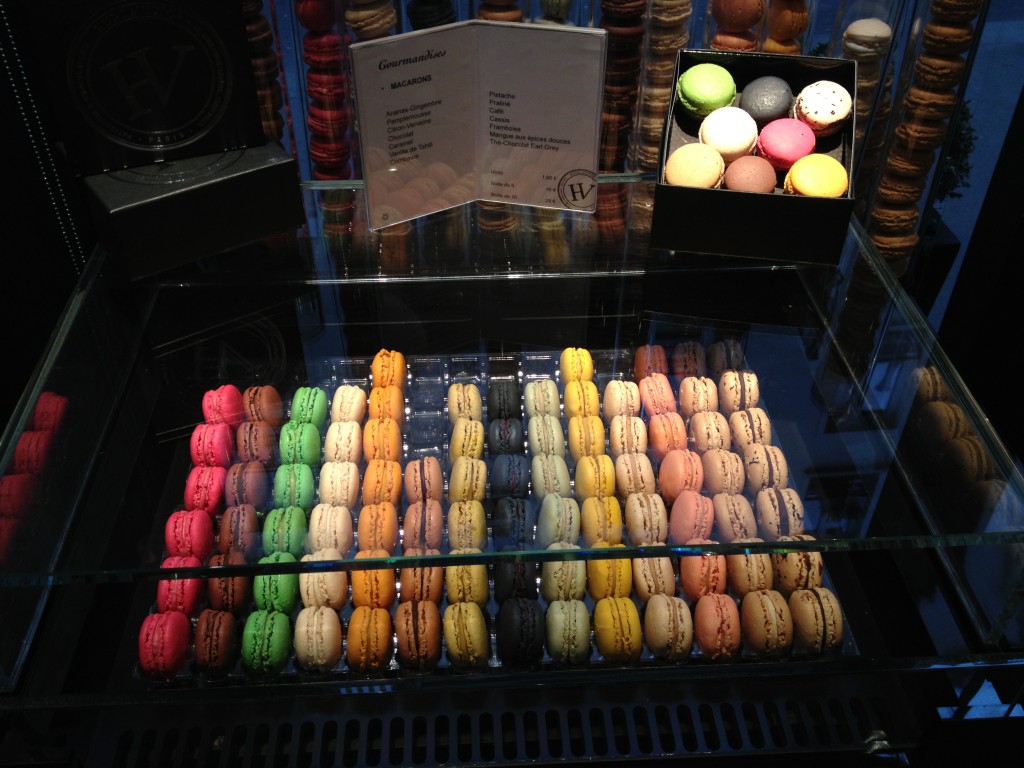
In the early fall you can savour the St Honorée Chestnut cake, but also other pastry and macaroons flavoured with verbena, figs, almonds, combawa, mirabelles, pears, grapes as well as pomegranate, tangerine, apple and lemon. It is practical though that anyone can get throughout the entire year the classical french breakfast items such as Brioche, Croissant, Pain au chocolat, and even own blends of ice-creams (Vanilla, Jorge Amado, Pistachio, Lemon Cheesecake) and sorbets (Grapefruit, Victor Strawberry, Montezuma, Verbena) whether it is winter or summer anyone with a sweet tooth can always be in the mood for one of these treats.
Locations:
Boutique Rive Gauche 40 Blvd Raspail, 75007 Paris. Mon-Sat: 9am-8pm; Sun: 10am-6pm
Boutique Marché Saint Honoré 7 rue Gomboust, 75001 Paris. Mon-Wed: 10:30am-7pm; Thurs-Sat: 10:30am-8pm; Sun: 11am-5pm.
Printemps Haussmann – RdC de la Mode 64 Blvd Haussmann, 75009 Paris. Mon-Sat: 9:35am-8pm (on Thurs until 10pm).
Caves Madeleine: where the winemakers eat in Beaune
Caves Madeleine is a casual bistro, a hole in the wall and a cosy cave du vin hidden in the cobbled maze of Medieval Beaune in Burgundy. Since there are not many tables inside, you will probably end up eating at a large community table not allowing for much privacy but for a bon vivant like camaraderie with bottles being shuffled around so you taste everyone’s bottle, of course if he is willing to share.

Forget about secrets and romantic rendezvous and share your joy from the genuine local food and wine with everyone inside the Caves Madeleine. The pleasant locals serving you as well as the cooks shrunk inside the tiny kitchen behind the bar, are all very friendly and almost blend with the guests inside. Who said all the french were frowning and disinterested? We were informed about the specialities of the house as well as the seasonal treasures on the ever-changing chalkboard menu, but we were also guided to selecting the right bottle fitting our budget and ideal for the food we chose to eat there.

Since the menu was all written in French, a puzzle for most foreigners, the waiters were essential to help with translation. If something has “assiette” in the name, then you will get a plate of something basic – like a plate of cold cut meats or assorted cheese. A “velouté” signified a warm creamy soup, while a “terrine” is usually made of meat pressed into a brick shape and served cold as a hearty starter. In October the mushroom season was in the full swing in Burgundy so the Velouté was made with the meaty cèpes mushrooms. Also known as porcini, the chunky mushrooms were generously rising above the creamy, soothing warm and hearty soup. Nicely done for such a casual eatery.
My sister went for the vegetarian main plate of Ravioles du Royans, crème aigrelette, which were thin ravioli pasta filled with vegetables in a creamy yet slightly tart sauce. The plate was sprinkled with chopped chives and toasted powdered nuts. A delicious treat balanced by the fresh greens and the thin skin of the ravioli made the cream less heavy-feeling. This dish called for a bolder white wine with a good acidity to cut through the fatty cream though.

I tried one of the signature dishes – the Quenelle de Volaille fermière, cèpes in a cream sauce, and I would order it again! This deep plate of a frothy cream with sizzling hot cep mushrooms covering a smooth pounded dumpling in a sausage shape (quenelle) made with a farm rised poultry and egg whites, poached in water or stock, is typical meal in Burgundy. Today, not many restaurants make this dish in the traditional way, meaning pounding and pressing repeatedly until an ideal smooth texture is achieved and then boiled until cooked. At Caves Madeleine they are not afraid of time-consuming traditional cooking and my satisfied taste buds appreciated the labour that went into it by finishing the last drops of the sauce. Depending on the season the dumplings can be made with fish or meat.
Pick your label at Caves Madeleine
There is nothing like a wine list to be found around. Get a local wine by the glass (you are in the heart of Burgundy so you bet it will be at least good) or pick a bottle from the display alongside the wall behind the communal table. The prices on the bottles are for take out, but adding only modest €6 corkage opens it inside. All of our dishes were rich and creamy, which is typical for authentic Burgundian cuisine, therefore we needed sufficient acidity to cut the fat and heaviness of our meals. A Chardonnay with a robust body and still slightly zesty character from Rully, the Southern part of Burgundy, offers a better value for money for its juicy crops. The Premier Cru Rully from Domaine Vincent Dureuil-Janthial 2011 was exactly what we looked for. Priced at €39 per bottle at the restaurant, it was not a bad deal either. No wonder that the locals including the winemakers and many of the winery owners love this genuine place. They can try their neighbour’s wines or bring their own and compare their sacred juices in the convivial atmosphere of Caves Madeleine.
The traditional Burgundian cuisine at Caves Madeleine in Beaune is a great value for money, and what makes it even more enjoyable are the very low margins on the wines sold in and to take away.
Daily except weekends and lunch on Wednesday.
8 Fauburg Madeleine, 21200 Beaune, France.
+33 3 80 22 93 30




